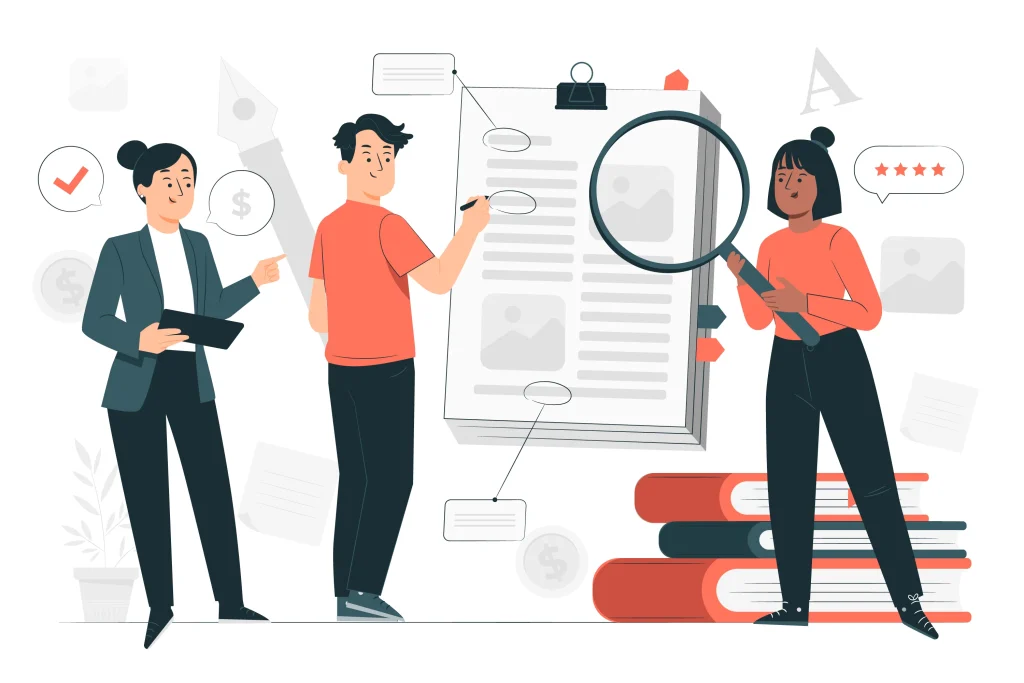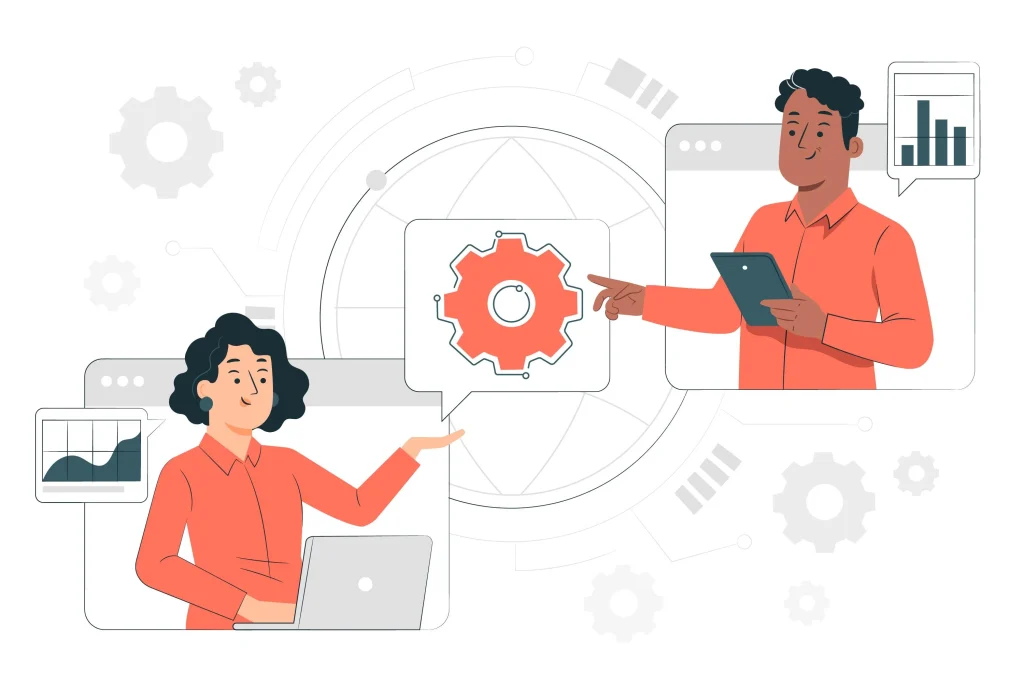
In the ever-evolving business landscape, founders are responsible for navigating uncharted territories, seeking innovation, and steering their organizations toward success. At the heart of this journey lies the intricate realm of Human Resources (HR), an indispensable facet that shapes the very fabric of an organization. For founders, understanding the nuanced intricacies of HR is not merely a choice; it is a necessity that lays the groundwork for a resilient and thriving enterprise.
As we unravel the layers of HR management, we invite founders to embark on a transformative journey that transcends policies and procedures, reaching into the very soul of the workplace. In understanding and embracing these HR fundamentals, founders unlock the potential to build successful businesses and foster cultures where employees thrive, driving the organization toward sustained excellence.
Recruitment and Onboarding
1. Talent Acquisition:
- Strategic Planning: Founders must initiate the recruitment process with a strategic mindset, identifying the skills and attributes crucial for each role within the organization. This involves aligning recruitment strategies with the company’s short-term goals and long-term vision.
- Effective Job Descriptions: Crafting clear and enticing job descriptions is paramount. These documents should not only outline the responsibilities of the role but also highlight the unique opportunities and culture that the organization offers.
- Utilizing Online Platforms: In the digital age, founders should leverage online platforms, job boards, and professional networks to cast a wide net for potential candidates. This expands the reach beyond local boundaries, attracting diverse and skilled individuals.
- Networking and Referrals: Establishing and nurturing professional networks can be a valuable source of talent. Additionally, founders should encourage and incentivize employee referrals, tapping into the trusted connections within the existing workforce.
2. Onboarding:
- Structured Onboarding Process: The onboarding process is the first impression a new hire receives, and founders should ensure it is structured and comprehensive. From introducing company policies to facilitating team integration, the onboarding program sets the tone for a positive employee experience.
- Training and Development Initiatives: Founders should prioritize training and development initiatives during the onboarding phase. This includes providing necessary technical training, introducing company tools and systems, and offering insights into the broader industry landscape.
- Mentorship Programs: Implementing mentorship programs can significantly enhance the onboarding experience. Assigning a seasoned employee to guide and support new hires fosters a sense of belonging and accelerates the integration process.
- Feedback Mechanisms: Establishing feedback mechanisms early on is crucial. Encouraging new hires to share their experiences and address any concerns helps founders refine and improve the onboarding process continually.
- Cultural Assimilation: Beyond procedural aspects, founders should emphasize cultural assimilation. Conveying the organization’s values, mission, and vision during onboarding ensures that new team members align with the company’s ethos.
- Regular Check-ins: Founders should conduct regular check-ins with new hires during the initial weeks and months. This provides an opportunity to address any challenges promptly, gauge satisfaction levels, and reinforce the company’s commitment to their professional growth.
By focusing on these intricacies of recruitment and onboarding, founders lay the groundwork for a workforce that is not only skilled but also deeply connected to the organization’s mission and values. This investment in the initial stages sets the stage for a collaborative and thriving workplace culture, where employees are empowered to contribute effectively to the company’s success.s providing necessary training and support to ensure a smooth integration into the team.

Employee Policies and Handbook
1. Policy Development:
- Comprehensive Documentation: Founders should spearhead the development of comprehensive and clear policies that govern various aspects of employment. This encompasses guidelines related to conduct, communication, performance expectations, and compliance with legal regulations.
- Legal Compliance: A thorough understanding of employment laws and regulations is essential. Founders should ensure that all policies are in compliance with local, national, and international labor laws to mitigate legal risks.
- Regular Review and Update: The business landscape evolves, and so should policies. Founders should commit to regular reviews of employee policies, ensuring they remain aligned with industry standards, organizational values, and the ever-changing legal landscape.
- Transparent Communication: Policies should be communicated transparently to all employees. Founders must facilitate open dialogue, addressing any queries or concerns, and fostering an environment where employees feel informed and supported.
2. Employee Handbook:
- Centralized Resource: The employee handbook serves as a centralized resource for all company policies, procedures, and essential information. Founders should ensure its accessibility to all employees, either through a physical copy or a secure digital platform.
- Orientation Session: During the onboarding process, founders should conduct orientation sessions specifically dedicated to familiarizing new hires with the contents of the employee handbook. This ensures that employees are aware of the organization’s expectations from the outset.
- Multilingual Considerations: In diverse work environments, founders should consider providing the employee handbook in multiple languages to accommodate the needs of a multicultural workforce. This demonstrates a commitment to inclusivity and accessibility.
- Acknowledgment and Agreement: Founders should implement a formal process where employees acknowledge receipt of the handbook and agree to adhere to the outlined policies. This not only ensures understanding but also establishes a basis for accountability.
- Updates and Version Control: As policies evolve, so should the employee handbook. Founders should implement a system for version control, clearly communicating updates and changes to all employees.
- Integration with Training Programs: The handbook should not be a static document but an integral part of ongoing training programs. Founders should emphasize its importance in shaping organizational culture and guiding employee behavior.
By meticulously crafting and maintaining employee policies and handbooks, founders provide a framework for consistent and fair treatment and contribute to developing a positive workplace culture. When effectively utilized, the handbook becomes a tool for aligning employees with the company’s values and fostering a harmonious work environment.

Performance Management
1. Goal Setting:
- Strategic Alignment: Founders play a pivotal role in aligning individual and team goals with the organization’s overarching objectives. These goals should be SMART (Specific, Measurable, Achievable, Relevant, and Time-bound) and contribute directly to the company’s mission and vision.
- Collaborative Process: Engage employees in the goal-setting process to foster a sense of ownership and commitment. Establishing open communication channels ensures that goals are not only realistic but also inspiring and motivational.
- Regular Review and Adjustments: Goals should not be static. Founders should institute regular review sessions to assess progress, make necessary adjustments, and provide continuous feedback. This adaptability ensures that goals remain relevant in dynamic business environments.
2. Feedback and Appraisals:
- Constructive Feedback Culture: Founders should cultivate a culture of constructive feedback within the organization. This involves not only providing feedback to employees but also encouraging employees to provide feedback to their peers and superiors.
- Regular Check-ins: In addition to formal performance appraisals, regular one-on-one check-ins between employees and their supervisors should be established. This ongoing communication allows for timely feedback, clarification of expectations, and the identification of areas for improvement.
- Recognition of Achievements: Acknowledge and celebrate individual and team achievements. Founders should actively participate in recognizing outstanding performance, reinforcing a positive work culture and motivating employees.
- Development Plans: Performance appraisals should not solely focus on past performance but also include discussions on future development. Founders should collaborate with employees to create personalized development plans that align with career goals and organizational needs.
- Fair and Consistent Evaluation: Founders should ensure that performance evaluations are fair and consistent across all employees. Establishing clear evaluation criteria and using standardized methods mitigate bias and promote a culture of fairness.
3. Performance Improvement Plans:
- Identification of Challenges: When performance falls below expectations, founders should initiate a Performance Improvement Plan (PIP). This involves identifying specific challenges, providing support, and setting clear expectations for improvement.
- Collaborative Approach: PIPs should be collaborative efforts, involving both the employee and their supervisor. Founders should emphasize support and guidance, fostering an environment where employees feel empowered to address and overcome challenges.
- Transparent Communication: Clear communication is crucial during the implementation of a PIP. Founders should ensure that employees understand the plan, the expectations, and the support mechanisms in place. Transparency builds trust and encourages commitment to improvement.
4. Recognition and Rewards:
- Merit-Based Recognition: Founders should establish merit-based recognition programs that acknowledge exceptional performance. This can include monetary rewards, promotions, or other tangible benefits, creating a culture where hard work is consistently valued.
- Peer Recognition: In addition to top-down recognition, founders should encourage peer-to-peer recognition. This not only boosts morale but also fosters a collaborative atmosphere where employees appreciate and acknowledge each other’s contributions.
- Fair and Equitable Reward Systems: When implementing reward systems, founders should ensure fairness and equity. Transparent criteria for rewards and a clear communication strategy help avoid misunderstandings and maintain a positive work environment.
By actively engaging in performance management processes, founders not only guide the development of individual employees but also contribute to the overall success and sustainability of the organization. A well-executed performance management system catalyzes employee growth, motivation, and continuous improvement.

Employee Engagement
1. Recognition and Rewards:
- Personalized Recognition: Founders should personalize recognition efforts, acknowledging individual achievements in a meaningful way. This can include public shout-outs, personalized notes, or small tokens of appreciation tailored to each employee’s preferences.
- Timely Acknowledgment: Timeliness is key in recognition. Founders should ensure that achievements are acknowledged promptly, reinforcing a culture where hard work is noticed and celebrated in real-time.
- Tangible Rewards: Beyond verbal recognition, tangible rewards such as bonuses, extra time off, or professional development opportunities can serve as powerful motivators. Founders should establish fair and transparent reward systems that align with organizational values.
2. Communication Channels:
- Open and Transparent Communication: Founders play a crucial role in fostering open and transparent communication channels. Regular updates on company performance, strategic direction, and challenges contribute to a sense of inclusion and shared purpose.
- Feedback Mechanisms: Implementing feedback mechanisms, such as suggestion boxes or regular surveys, allows employees to voice their opinions and contribute to decision-making processes. Founders should actively seek and act upon constructive feedback.
- Two-Way Communication: Create platforms for two-way communication where employees feel comfortable sharing their thoughts and concerns. Town hall meetings, Q&A sessions, or digital forums can facilitate meaningful dialogue.
3. Professional Development:
- Investment in Growth: Founders should view professional development as an investment in both individual employees and the organization. Providing opportunities for skill enhancement, workshops, and mentorship programs not only boosts morale but also contributes to the company’s overall expertise.
- Individual Development Plans: Work collaboratively with employees to create individual development plans aligned with their career aspirations and organizational needs. Founders should demonstrate a commitment to supporting employees in achieving their professional goals.
- Learning Culture: Foster a learning culture within the organization where continuous improvement and knowledge-sharing are valued. Founders should lead by example, emphasizing the importance of staying abreast of industry trends and acquiring new skills.
4. Wellness Initiatives:
- Work-Life Balance: Founders should prioritize work-life balance by implementing policies that promote flexible schedules, remote work options, and reasonable working hours. A healthy balance contributes to overall well-being and job satisfaction.
- Wellness Programs: Establish wellness programs that encompass physical, mental, and emotional well-being. This can include fitness challenges, mindfulness sessions, or access to mental health resources. Founders should actively promote participation in these initiatives.
- Employee Assistance Programs: Provide access to Employee Assistance Programs (EAPs) that offer confidential support for personal and professional challenges. Founders should communicate the availability of these resources to reduce stigma and encourage utilization.
5. Team Building and Social Events:
- Collaborative Team Building: Founders should actively encourage team-building activities that foster collaboration and strengthen interpersonal relationships. This can range from team-building exercises to collaborative projects that transcend departmental boundaries.
- Celebrating Milestones: Acknowledge and celebrate both personal and professional milestones within the team. Founders should actively participate in these celebrations, reinforcing a sense of camaraderie and shared achievements.
- Social Events: Organize social events that provide opportunities for employees to unwind and connect on a personal level. Whether it’s a casual Friday lunch or a team outing, these events contribute to a positive and inclusive workplace culture.
6. Career Growth Opportunities:
- Clear Career Paths: Founders should provide employees with clear visibility into potential career paths within the organization. This clarity fosters a sense of purpose and motivates employees to invest in their professional development.
- Promotions and Advancements: Actively identify and nurture internal talent for promotions and advancements. Recognizing and promoting from within not only boosts morale but also demonstrates a commitment to employee growth.
- Skill Enhancement Programs: Offer skill enhancement programs and training opportunities that align with employees’ career aspirations. Founders should actively support employees in acquiring new skills relevant to their roles and future aspirations.
In actively engaging with these employee engagement strategies, founders create a workplace ecosystem where individuals are contributors and active participants in the organization’s journey. By cultivating a culture of recognition, open communication, and continuous growth, founders lay the groundwork for a thriving and interconnected workforce.

Compliance and Legal Matters
1. Understanding Employment Laws:
- Local, National, and International Regulations: Founders must possess a comprehensive understanding of employment laws at the local, national, and international levels, depending on the scope of their operations. This includes regulations related to hiring, termination, working hours, wages, and benefits.
- Regular Legal Updates: Employment laws are subject to change. Founders should establish mechanisms to stay informed about any changes in legislation that may impact the organization. This could involve subscribing to legal newsletters, participating in industry forums, or consulting with legal experts.
- Legal Compliance Audits: Conduct regular legal compliance audits to ensure that all HR policies and practices align with the latest legal requirements. This proactive approach helps mitigate the risk of legal disputes and penalties.
2. Development of HR Policies:
- Clear and Comprehensive Policies: Founders should actively contribute to the development of clear and comprehensive HR policies. These policies should cover a range of areas, including anti-discrimination, harassment, confidentiality, and code of conduct, ensuring that employees are aware of the organization’s expectations.
- Alignment with Legal Standards: HR policies should align with legal standards to prevent any potential legal disputes. Founders should work closely with legal professionals to ensure that policies are both enforceable and compliant with applicable laws.
- Distribution and Training: Once developed, policies should be distributed to all employees, and training sessions should be conducted to ensure that employees understand the policies. This not only fosters compliance but also creates a culture of accountability.
3. Disciplinary Procedures:
- Establishing Fair and Consistent Practices: Founders should play a pivotal role in establishing fair and consistent disciplinary procedures. This involves defining a clear escalation process, from informal discussions to formal written warnings, ensuring that all employees are treated equitably.
- Documentation: Documenting all disciplinary actions is crucial. Founders should emphasize the importance of thorough record-keeping, which can serve as evidence in case of legal disputes. This documentation should be stored securely and easily accessible if needed.
- Legal Consultation: In cases of complex or sensitive disciplinary matters, founders should seek legal consultation. Legal experts can provide guidance on navigating intricate legal considerations and minimizing legal risks associated with disciplinary actions.
4. Workplace Safety and Health Compliance:
- Safety Regulations Adherence: Founders are responsible for ensuring that the workplace adheres to safety regulations. This includes providing necessary safety training, implementing emergency response plans, and maintaining a safe working environment.
- Ongoing Safety Audits: Regular safety audits should be conducted to identify and rectify potential hazards. Founders should collaborate with safety professionals to implement best practices and adhere to occupational health and safety standards.
- Employee Well-being Programs: Implementing employee well-being programs contributes to both physical and mental health, indirectly aligning with safety and health compliance. These programs can include stress management initiatives, ergonomic assessments, and mental health resources.
5. Confidentiality and Data Protection:
- Data Privacy Policies: Founders should actively contribute to the development of data privacy policies to safeguard employee information. These policies should comply with data protection laws and clearly outline how employee data is collected, processed, and stored.
- Employee Training on Data Security: Employees should be educated on the importance of data security and confidentiality. Founders should ensure that training programs cover topics such as password protection, secure file handling, and recognizing phishing attempts.
- Incident Response Plans: In the event of a data breach or confidentiality violation, founders should have incident response plans in place. These plans outline the steps to be taken to investigate, contain, and remediate any breaches, ensuring compliance with data protection laws.
6. Diversity and Inclusion Compliance:
- Anti-Discrimination Policies: Founders should actively support and enforce anti-discrimination policies within the organization. These policies should promote a diverse and inclusive workplace, prohibiting any form of discrimination based on race, gender, ethnicity, age, or other protected characteristics.
- Equal Opportunity Employment: Adhering to equal opportunity employment principles is essential. Founders should ensure that hiring, promotion, and termination decisions are based on merit, qualifications, and job-related criteria, without discrimination.
- Accessibility Compliance: For organizations with a digital presence, founders should consider accessibility compliance. This includes ensuring that digital platforms and communications are accessible to individuals with disabilities, in accordance with applicable laws.
By prioritizing compliance with legal standards, founders create a foundation of integrity and ethical conduct within the organization. This mitigates legal risks and establishes a culture of trust and accountability among employees.

Diversity and Inclusion
1. Inclusive Recruitment Practices:
- Diverse Talent Sourcing: Founders should actively pursue diverse talent sourcing strategies to attract individuals from various backgrounds. This may involve partnering with diverse recruitment agencies, attending career fairs focused on underrepresented groups, and utilizing inclusive language in job postings.
- Unbiased Selection Processes: Implementing unbiased selection processes ensures fair evaluation of candidates. Founders should encourage diverse hiring panels, blind resume reviews, and structured interviews to minimize unconscious biases in decision-making.
- Metrics and Analysis: Establish metrics to track diversity in the recruitment pipeline. Regularly analyze these metrics to identify any potential gaps or areas for improvement, allowing for data-driven decision-making in recruitment strategies.
2. Inclusive Workplace Policies:
- Anti-Discrimination Policies: Clearly articulate and enforce anti-discrimination policies that explicitly state the organization’s commitment to fostering a workplace free from discrimination based on race, gender, ethnicity, sexual orientation, disability, or other protected characteristics.
- Accommodation and Accessibility: Ensure workplace policies include provisions for reasonable accommodations to support individuals with disabilities. This involves providing accessible facilities, technology, and flexible work arrangements to create an inclusive environment.
- Flexible Work Practices: Implementing flexible work practices accommodates diverse needs. Founders should promote policies such as flexible work hours, remote work options, and job-sharing arrangements to create an inclusive workplace that supports various lifestyles.
3. Diversity Training and Education:
- Mandatory Diversity Training: Founders should mandate diversity training for all employees, including leadership. These programs should focus on raising awareness about unconscious biases, promoting cultural competence, and fostering an understanding of the importance of diversity and inclusion.
- Leadership Development Programs: Establish leadership development programs that emphasize the value of diverse leadership. Encourage mentorship and sponsorship initiatives to support underrepresented individuals in advancing their careers within the organization.
- Ongoing Learning Opportunities: Foster a culture of continuous learning by providing ongoing opportunities for employees to engage in diversity and inclusion education. This can include workshops, webinars, and access to resources that promote understanding and allyship.
4. Employee Resource Groups (ERGs):
- Establishment of ERGs: Founders should support the creation of Employee Resource Groups (ERGs) that represent different demographic or affinity groups within the organization. ERGs provide a platform for employees to connect, share experiences, and contribute to a more inclusive workplace.
- Leadership Support for ERGs: Encourage leadership involvement and support for ERGs. This includes providing resources, allocating time for ERG activities, and actively considering ERG input in decision-making processes.
- ERG Impact Measurement: Establish metrics to measure the impact of ERGs on the organization’s diversity and inclusion goals. Regularly assess the effectiveness of ERG initiatives and use feedback to refine and expand their impact.
5. Equal Opportunities for Growth:
- Promotion Based on Merit: Founders should ensure that promotion and advancement opportunities are based on merit, skills, and achievements, rather than favoring specific groups. Implement transparent promotion processes to build trust and equity.
- Succession Planning: Integrate diversity considerations into succession planning to identify and develop a pipeline of diverse talent for leadership roles. This proactive approach ensures a diverse leadership team in the long term.
- Mentorship and Sponsorship: Establish mentorship and sponsorship programs to provide guidance and support for underrepresented employees. This facilitates career development and helps break down barriers to advancement.
6. Diversity Metrics and Reporting:
- Data Collection: Founders should establish mechanisms to collect and analyze diversity metrics, including representation at different organizational levels, pay equity, and employee satisfaction. Collecting demographic data voluntarily and anonymously helps in understanding the organization’s diversity landscape.
- Regular Reporting: Transparently report diversity metrics to all employees, showcasing the organization’s commitment to accountability and improvement. Regular reporting fosters trust and signals to employees that diversity and inclusion are priorities.
- Benchmarking and Industry Comparisons: Benchmarking diversity metrics against industry standards allows founders to identify areas of strength and improvement. This external comparison can guide strategies to ensure the organization remains competitive in fostering diversity.
By actively engaging in these diversity and inclusion initiatives, founders contribute to creating a workplace that celebrates differences, values unique perspectives, and empowers every individual to reach their full potential. The result is a more innovative, resilient, and harmonious organization that reflects the diversity of the global community.

Training and Development
1. Continuous Learning Culture:
- Emphasis on Lifelong Learning: Founders should instill a culture of continuous learning, emphasizing that professional development is a lifelong journey. This involves fostering curiosity, adaptability, and a mindset that values ongoing improvement.
- Learning Opportunities for All Levels: Provide learning opportunities for employees at all levels of the organization. From entry-level positions to leadership roles, founders should ensure that training programs cater to diverse skill sets and career stages.
- Access to Learning Resources: Establish easily accessible learning resources, such as online courses, workshops, and industry publications. Founders should encourage employees to explore new skills, stay informed about industry trends, and expand their knowledge base.
2. Professional Development Programs:
- Individual Development Plans: Collaborate with employees to create individual development plans that align with their career aspirations and organizational needs. Founders should actively support employees in identifying areas for growth and setting achievable professional goals.
- Leadership Development Initiatives: Implement leadership development programs to groom and empower future leaders within the organization. These initiatives can include mentorship programs, leadership training workshops, and exposure to strategic decision-making processes.
- Cross-Functional Training: Provide opportunities for employees to engage in cross-functional training. This not only broadens their skill set but also fosters a deeper understanding of different facets of the organization.
3. On-the-Job Training
- Mentorship Programs: Establish mentorship programs that pair experienced employees with those seeking guidance. On-the-job mentorship provides practical insights, accelerates skill development, and contributes to a collaborative work environment.
- Job Rotation Initiatives: Implement job rotation initiatives that allow employees to gain exposure to different roles and responsibilities within the organization. This hands-on experience enhances versatility and contributes to a well-rounded skill set.
- Learning by Doing: Encourage learning by doing. Founders should create an environment where employees feel empowered to take on new challenges, experiment with innovative solutions, and learn from both successes and failures.
4. Skills Enhancement Workshops:
- Tailored Workshops: Organize skills enhancement workshops that target specific areas identified as crucial for organizational success. These workshops can cover technical skills, soft skills, or industry-specific knowledge.
- External Expert Sessions: Bring in external experts to conduct workshops or training sessions. This provides employees with fresh perspectives, exposes them to industry best practices, and fosters a culture of continuous improvement.
- Feedback and Iteration: Solicit feedback from participants after workshops and use it to iterate and improve future sessions. This ensures that training programs remain relevant and effective in addressing the evolving needs of the workforce.
5. Technology-Based Learning:
- E-Learning Platforms: Leverage e-learning platforms to provide flexible and accessible training resources. These platforms can include online courses, webinars, and interactive modules that accommodate different learning styles.
- Digital Skill Development: Recognize the importance of digital skills in the modern workplace. Founders should invest in training programs that enhance employees’ digital literacy, keeping them adept at utilizing technology to its fullest potential.
- Gamification Elements: Incorporate gamification elements into training programs to enhance engagement and motivation. Features such as badges, leaderboards, and interactive quizzes can make learning more enjoyable and effective.
6. Measurement of Training Effectiveness:
- Establish Key Performance Indicators (KPIs): Define KPIs to measure the effectiveness of training programs. This could include improvements in job performance, increased productivity, or enhanced employee satisfaction.
- Post-Training Assessments: Conduct post-training assessments to evaluate the retention and application of knowledge. This allows founders to gauge the impact of training on employees’ day-to-day responsibilities.
- Feedback Surveys: Gather feedback from participants through surveys to understand their perspectives on the training experience. Analyzing this feedback provides insights into areas of improvement and helps tailor future training initiatives.
7. Leadership Training and Soft Skills Development:
- Leadership Skill Enhancement: Prioritize leadership training programs that focus on developing essential leadership skills. This includes communication, emotional intelligence, decision-making, and conflict resolution.
- Soft Skills Workshops: Recognize the significance of soft skills in interpersonal relationships and team dynamics. Conduct workshops on communication, teamwork, adaptability, and other soft skills to foster a positive and collaborative work environment.
- Executive Coaching: Provide executive coaching opportunities for leaders within the organization. This personalized approach supports leaders in honing their leadership style, addressing challenges, and maximizing their potential.
8. Collaboration with External Training Providers:
- Strategic Partnerships: Collaborate with external training providers and institutions to bring specialized expertise to the organization. This can include industry certifications, accredited courses, or workshops led by recognized experts.
- Tailored Training Programs: Work with external providers to tailor training programs to the organization’s unique needs and industry demands. This ensures that the training content is directly applicable and aligns with the organization’s goals.
- Continuous Evaluation of Partnerships: Regularly evaluate the effectiveness of partnerships with external training providers. Ensure that providers align with the organization’s values, deliver high-quality content, and contribute positively to employee development.
Founders who prioritize training and development invest in their employees’ skill sets and cultivate a culture of continuous improvement and adaptability. This commitment to learning propels the organization forward, ensuring it remains agile, innovative, and well-equipped for the challenges of a dynamic business landscape.

Employee Well-being
Recognize the importance of employee well-being, offering resources and support for mental health. Implement wellness programs and initiatives to foster a healthy work-life balance.
1. Mental Health Support:
- Mental Health Programs: Founders should prioritize mental health by implementing programs that raise awareness, reduce stigma, and provide resources for mental health support. These programs can include counseling services, stress management workshops, and access to mental health professionals.
- Flexible Work Arrangements: Recognizing the impact of work-related stress, founders should consider flexible work arrangements. This may involve remote work options, compressed workweeks, or the provision of mental health days to support employees in managing their well-being.
- EAPs (Employee Assistance Programs): Establish Employee Assistance Programs that offer confidential counseling services and resources for personal and professional challenges. EAPs provide employees with a safe and supportive outlet for addressing mental health concerns.
2. Physical Wellness Initiatives:
- Fitness Programs: Implement fitness programs to promote physical well-being. This may include onsite fitness classes, gym memberships, or incentives for physical activities. Physical wellness contributes not only to health but also to increased energy and productivity.
- Ergonomic Workspaces: Create ergonomic workspaces to minimize the risk of musculoskeletal issues. Providing comfortable chairs, adjustable desks, and proper lighting supports employee physical health and enhances overall well-being.
- Health Screenings: Offer regular health screenings or check-ups to employees. Early detection of health issues can lead to timely interventions and supports a proactive approach to employee well-being.
3. Work-Life Balance Policies:
- Clear Expectations: Establish clear expectations regarding working hours and overtime. Founders should encourage employees to maintain a healthy work-life balance and discourage a culture of excessive overtime, which can lead to burnout.
- Remote Work Options: Embrace remote work options to accommodate diverse employee needs. Remote work not only provides flexibility but also reduces commuting stress and contributes to a better work-life balance.
- Paid Time Off Policies: Ensure that paid time off policies are transparent and encourage employees to take the time they need for rest and relaxation. A well-rested workforce is more productive and resilient.
4. Financial Well-being Support:
- Financial Education Programs: Offer financial education programs to help employees manage their finances effectively. This can include workshops on budgeting, investment planning, and debt management to alleviate financial stress.
- Competitive Compensation: Ensure that the organization provides competitive and fair compensation. Financial stability is a crucial component of well-being, and founders should regularly review and adjust salaries to reflect market standards.
- Employee Assistance Programs (EAPs): Implement EAPs that include financial counseling services. These confidential resources can provide employees with guidance on financial planning and address any concerns they may have.
5. Social Connection and Inclusion:
- Team-building Activities: Facilitate team-building activities to strengthen social connections among employees. This can include regular team outings, virtual social events, and activities that foster a sense of camaraderie.
- Inclusive Culture: Cultivate an inclusive culture where all employees feel valued and included. Founders should actively promote diversity and create an environment where different perspectives are acknowledged and respected.
- Employee Resource Groups (ERGs): Encourage the formation of ERGs that focus on various aspects of diversity and inclusion. These groups provide a platform for employees to connect, share experiences, and contribute to a more inclusive workplace.
6. Technology Integration for Well-being:
- Digital Well-being Apps: Introduce digital well-being apps that help employees manage and monitor their screen time. These apps may include features to remind employees to take breaks, set boundaries for device usage, and promote a healthier balance between work and personal life.
- Wellness Platforms: Implement wellness platforms that offer resources, challenges, and information on physical and mental health. These platforms can serve as centralized hubs for employees to access well-being content, participate in fitness challenges, and track their progress.
- Flexible Technology Policies: Recognize the importance of flexible technology usage policies. Encourage employees to disconnect during non-working hours, set realistic expectations for response times, and foster a culture that values well-being over constant connectivity.
7. Well-being Assessments and Surveys:
- Regular Well-being Surveys: Conduct regular surveys to assess employee well-being. Gather feedback on the effectiveness of existing well-being initiatives and identify areas for improvement. Employee input is valuable in shaping a well-rounded well-being program.
- Individual Well-being Assessments: Offer individual well-being assessments to employees. These assessments can help employees identify specific areas of concern and provide personalized recommendations for improving their overall well-being.
- Actionable Insights: Use the data collected from surveys and assessments to derive actionable insights. This information can guide the development of targeted well-being programs, ensuring that initiatives address the specific needs and preferences of the workforce.
8. Recognition and Appreciation Programs:
- Employee Recognition Programs: Implement employee recognition programs that acknowledge and appreciate individual and team achievements. Recognizing contributions boosts morale and reinforces a positive work culture.
- Peer Recognition Platforms: Introduce platforms that allow employees to recognize and appreciate their peers. Peer-to-peer recognition fosters a sense of camaraderie and creates a supportive environment where achievements are celebrated collaboratively.
- Continuous Feedback Channels: Establish continuous feedback channels for ongoing recognition. Whether through regular team meetings, digital platforms, or dedicated recognition ceremonies, founders should encourage a culture where appreciation is expressed consistently.
By prioritizing employee well-being, founders contribute to their workforce’s health and happiness and foster a positive organizational culture. A workplace that values and supports the well-being of its employees is more likely to attract and retain top talent, drive innovation, and achieve sustainable success.

Technology Integration
Explore and implement HR software solutions to automate repetitive tasks, streamline recruitment processes, and enhance overall HR efficiency.
1. Digital Collaboration Tools:
- Project Management Platforms: Implement project management platforms that enhance collaboration and streamline workflow. These tools facilitate real-time communication, document sharing, and task management, promoting efficiency.
- Virtual Meeting Solutions: Utilize virtual meeting solutions for remote and global teams. Video conferencing tools enhance communication, foster team engagement, and reduce the challenges associated with geographical distances.
- Communication Apps: Integrate communication apps that allow instant messaging and quick information sharing. These tools promote seamless communication, reducing delays in decision-making and enhancing overall connectivity.
2. Learning Management Systems (LMS):
- Online Training Platforms: Invest in LMS for training and development purposes. These systems enable the organization to deliver online courses, track employee progress, and ensure that learning initiatives are accessible and efficient.
- Continuous Learning Platforms: Integrate continuous learning platforms that provide employees with opportunities for self-directed learning. This allows employees to acquire new skills at their own pace, contributing to professional development.
- Certification Tracking Systems: Utilize LMS to track certifications and qualifications. This ensures that employees are up-to-date with necessary certifications and that the organization remains compliant with industry standards.
3. Employee Well-being Apps:
- Wellness Tracking Apps: Introduce wellness tracking apps that help employees monitor and manage their physical and mental health. These apps can include features for tracking exercise, sleep patterns, and stress levels.
- Mental Health Support Platforms: Implement digital platforms that offer mental health resources and support. These platforms may provide access to counseling services, mindfulness exercises, and self-help resources for employees.
- Integration with Wearables: Explore integration with wearable devices that track health metrics. This can provide employees with personalized insights into their well-being and encourage healthy habits.
4. Performance Management Software:
- Automated Performance Reviews: Implement performance management software to streamline the performance review process. These tools automate feedback collection, goal tracking, and performance evaluations, enhancing efficiency.
- Data Analytics for Performance: Utilize data analytics within performance management software to gain insights into employee performance trends. This data-driven approach enables more informed decision-making regarding talent development and recognition.
- Employee Feedback Platforms: Integrate platforms for continuous feedback and recognition. Real-time feedback tools promote a culture of appreciation and allow employees to receive timely acknowledgment for their contributions.
5. Cybersecurity Measures:
- Secure Communication Channels: Ensure that communication channels, especially those containing sensitive information, are secure. Implement encrypted email systems and secure messaging apps to protect employee data and maintain confidentiality.
- Employee Training on Cybersecurity: Provide ongoing training on cybersecurity best practices. This includes educating employees about phishing risks, password security, and the importance of reporting any suspicious activities to enhance the organization’s overall security posture.
- Multi-Factor Authentication (MFA): Implement MFA for access to sensitive systems and data. This additional layer of security enhances protection against unauthorized access and strengthens the organization’s cybersecurity infrastructure.
6. AI for HR Processes:
- Automated Recruitment Processes: Leverage AI in recruitment processes to streamline candidate sourcing, screening, and initial assessments. This reduces administrative burdens on HR teams and ensures a more efficient hiring process.
- Predictive Analytics for Talent Management: Utilize predictive analytics in talent management to identify high-potential employees, anticipate skill gaps, and optimize workforce planning. AI-driven insights enable strategic decision-making for talent development.
- Chatbots for Employee Queries: Implement AI-powered chatbots for handling routine HR queries. This frees up HR professionals to focus on more complex tasks, while employees receive quick and accurate responses to common inquiries.
7. Digital Well-being Solutions:
- Screen Time Management Tools: Recognizing the impact of digital work on well-being, offer tools that help employees manage screen time. These tools can provide reminders for breaks, encourage eye exercises, and promote a healthier balance between digital and non-digital activities.
- Digital Detox Initiatives: Introduce initiatives that promote digital detox periods. This may include designated times when employees are encouraged to disconnect from digital devices to reduce stress and improve overall well-being.
- Technology Assessments: Conduct assessments to evaluate the impact of technology on employee well-being. Use employee feedback to make informed decisions about technology usage policies and identify areas for improvement.
By strategically integrating technology into various aspects of the organization, founders can optimize efficiency, foster connectivity, and create a digital infrastructure that supports both business objectives and the well-being of employees. This dual focus on technological advancement and employee welfare contributes to a dynamic and resilient workplace.

Succession Planning
Actively identify and develop potential leaders within the organization. Establish a succession plan to ensure a smooth transition in key roles.
1. Identification of Key Positions:
- Critical Roles Analysis: Conduct a thorough analysis to identify positions critical to the organization’s success. These may include leadership roles, key technical positions, and other roles essential for business continuity.
- Skills and Competencies Assessment: Evaluate the skills and competencies required for each identified role. Clearly outline the qualifications, experiences, and leadership traits necessary for success in these positions.
- Future Skills Mapping: Consider future skills and competencies that may become crucial as the industry evolves. Succession planning should address current needs and anticipate future requirements to ensure long-term organizational resilience.
2. Talent Identification and Development:
- High-Potential Identification: Identify high-potential employees who exhibit the skills and potential to assume key leadership roles in the future. This may involve performance assessments, feedback from managers, and a comprehensive review of employees’ career trajectories.
- Individual Development Plans: Work with high-potential employees to create individual development plans. These plans should outline specific developmental opportunities, training programs, and experiences that will prepare them for advancement.
- Leadership Development Programs: Implement leadership development programs tailored to address the identified skills and competencies. These programs may include workshops, mentoring, and exposure to cross-functional experiences to groom potential successors.
3. Knowledge Transfer and Mentorship:
- Knowledge Transfer Initiatives: Facilitate knowledge transfer from current incumbents to potential successors. This may involve creating formal mentorship programs, encouraging knowledge-sharing sessions, and documenting critical processes and insights.
- Successor-Mentor Pairing: Pair potential successors with experienced mentors who can provide guidance, share institutional knowledge, and offer insights into the nuances of leadership. Mentorship fosters a supportive learning environment for emerging leaders.
- Cross-Functional Experiences: Provide opportunities for potential successors to gain experience in different departments and functions. Exposure to various aspects of the business enhances their understanding and prepares them for a holistic leadership role.
4. Succession Planning Policies and Procedures:
- Formal Succession Planning Policies: Establish formal policies and procedures for succession planning. Clearly communicate these policies to employees, outlining the organization’s commitment to talent development and the criteria for identifying and promoting successors.
- Transparency in Selection Processes: Maintain transparency in the succession planning process. Clearly communicate the criteria for selection, and ensure that employees understand the pathways to advancement within the organization.
- Inclusion of Diversity Considerations: Embed diversity and inclusion principles into succession planning. Ensure that the pool of potential successors is diverse, representing a variety of backgrounds, perspectives, and experiences.
5. Continuous Monitoring and Evaluation:
- Regular Talent Reviews: Conduct regular talent reviews to assess the progress of potential successors. These reviews should involve leadership discussions, performance assessments, and adjustments to development plans based on evolving organizational needs.
- Feedback Loops: Establish feedback mechanisms for potential successors to receive constructive feedback on their performance and development. This iterative process allows for continuous improvement and ensures alignment with organizational goals.
- Scenario Planning: Anticipate potential disruptions or changes in leadership needs through scenario planning. This proactive approach enables the organization to adapt its succession plans based on evolving circumstances.
6. Contingency Planning:
- Identification of Backup Successors: In addition to primary successors, identify backup successors for critical roles. This provides an extra layer of preparedness and ensures that the organization is resilient in the face of unexpected changes.
- Emergency Succession Plans: Develop emergency succession plans for situations where immediate leadership changes are necessary. Clearly outline the steps to be taken, key contacts, and interim measures to maintain business continuity.
- Crisis Management Training: Provide training for potential successors in crisis management and decision-making. This equips them with the skills and resilience needed to navigate challenges effectively.
7. External Talent Acquisition Strategies:
- Benchmarking and External Scanning: Continuously benchmark internal talent against external talent. Regularly scan the external market for potential leaders who may bring fresh perspectives and skills to the organization.
- Strategic External Hires: Consider strategic external hires for key positions, especially when specific skills or experiences are lacking internally. This approach enriches the talent pool and brings in diverse perspectives.
- Networking and Industry Engagement: Encourage potential successors to actively engage with industry networks and associations. This not only broadens their knowledge but also positions them as visible leaders within the industry.
8. Alignment with Organizational Strategy:
- Strategic Alignment: Ensure that succession planning aligns with the overall organizational strategy. The identification and development of successors should be directly linked to the strategic goals and future direction of the company.
- Periodic Strategy Reviews: Regularly review the organizational strategy and adjust succession plans accordingly. Changes in market dynamics, industry trends, or internal goals may necessitate adjustments to the talent pipeline.
- Leadership Skills Forecasting: Anticipate the leadership skills and qualities that will be critical for the organization’s future success. Tailor succession planning efforts to address these specific leadership needs.
Succession planning is not just a reactive measure for replacing leaders; it is a proactive strategy to ensure that the organization is well-equipped with a pipeline of skilled and prepared leaders to guide it through planned and unforeseen transitions. By investing in the development and readiness of its future leaders, an organization secures its long-term success and adaptability in a dynamic business landscape.

Remote Work Policies
Establish clear policies for remote work, including expectations, communication protocols, and performance evaluation criteria.
1. Policy Framework:
- Clear Guidelines: Establish clear guidelines outlining the organization’s stance on remote work. Define the types of remote work arrangements available, whether full-time remote, hybrid, or occasional telecommuting.
- Eligibility Criteria: Clearly define eligibility criteria for remote work. Consider factors such as job roles, employee performance, and the nature of tasks to determine who is eligible for remote work opportunities.
- Compliance with Local Laws: Ensure that remote work policies comply with local labor laws and regulations. Understanding legal requirements helps prevent compliance issues and supports a seamless transition to remote work.
2. Communication Protocols:
- Digital Communication Tools: Specify the digital communication tools to be used for remote collaboration. Whether it’s video conferencing, messaging apps, or project management platforms, a standardized set of tools fosters efficient communication.
- Response Time Expectations: Communicate expectations regarding response times for emails, messages, and virtual meetings. Setting clear expectations helps maintain effective communication and prevents misunderstandings.
- Regular Check-ins: Establish protocols for regular check-ins between remote team members and their supervisors. Scheduled meetings, progress updates, and virtual team huddles contribute to team cohesion.
3. Equipment and Technology:
- Providing Necessary Equipment: Clarify the organization’s stance on providing necessary equipment for remote work, such as laptops, ergonomic accessories, and software licenses. This ensures that employees have the tools they need to perform their roles effectively.
- Security Measures: Outline security measures to be taken when working remotely. This includes guidelines on secure internet connections, VPN usage, and the protection of sensitive company information.
- IT Support: Communicate the availability of IT support for remote employees. Clear channels for reporting technical issues and obtaining assistance contribute to a smooth remote work experience.
4. Work Hours and Expectations:
- Defining Work Hours: Clearly define standard work hours for remote employees. This helps set expectations for availability and ensures alignment with organizational working hours.
- Flexibility: Acknowledge and communicate the organization’s stance on flexible work hours. Establishing guidelines for flexibility allows employees to balance work and personal responsibilities effectively.
- Overtime Policies: Clearly outline policies related to overtime work. Establish whether remote employees are expected to adhere to the same overtime policies as those working from the office.
5. Performance Measurement:
- Outcome-based Metrics: Shift the focus from monitoring time to measuring outcomes. Establish performance metrics that emphasize results, ensuring that remote employees are evaluated based on their contributions and achievements.
- Regular Performance Reviews: Maintain regular performance review cycles for remote employees. Consistent feedback and evaluations help identify areas for improvement and support professional growth.
- Goal Setting: Collaborate with remote employees to set clear, achievable goals. Clearly defined objectives contribute to employee motivation and alignment with organizational priorities.
6. Team Collaboration and Culture:
- Virtual Team Building: Incorporate virtual team-building activities to foster a sense of camaraderie among remote teams. This can include virtual social events, team challenges, and online workshops.
- Cultural Alignment: Reinforce the organization’s values and culture among remote employees. Regular communication about the company’s mission, vision, and core values helps maintain a cohesive organizational identity.
- Inclusive Practices: Implement inclusive practices that ensure remote employees feel part of the team. This may involve rotating meeting times to accommodate different time zones and actively seeking input from all team members.
7. Mental Health and Well-being:
- Encouraging Breaks: Emphasize the importance of taking breaks and setting boundaries. Remote employees should be encouraged to step away from their workstations, practice self-care, and avoid burnout.
- Access to Support Resources: Communicate the availability of mental health resources and support. This can include Employee Assistance Programs (EAPs), counseling services, and informational sessions on stress management.
- Well-being Check-ins: Incorporate regular well-being check-ins into team routines. These check-ins provide a platform for employees to express concerns, share successes, and maintain a sense of connection.
8. Compliance and Data Security:
- Data Protection Policies: Reiterate data protection policies for remote work. Ensure that remote employees are aware of and adhere to policies related to data security, confidentiality, and privacy.
- Legal Compliance: Communicate the importance of legal compliance when working remotely. Remote employees should be aware of their responsibilities regarding data protection laws, tax regulations, and other legal considerations.
- Regular Training: Conduct regular training sessions on compliance and data security. Keeping remote employees informed about best practices contributes to a secure and compliant remote work environment.
9. Return-to-Office Guidelines:
- Flexible Return Plans: If applicable, outline flexible return-to-office plans. Clearly communicate any phased approaches, hybrid work models, or options for employees to choose their preferred work location.
- Health and Safety Protocols: Provide information on health and safety protocols for employees returning to the office. Address concerns related to the COVID-19 pandemic or other health-related considerations.
- Communication Channels: Establish communication channels for updates on return-to-office plans. Transparent communication ensures that employees are well-informed and prepared for any changes.
10. Continuous Feedback and Iteration:
- Feedback Mechanisms: Implement continuous feedback mechanisms to gather insights from remote employees. This can involve surveys, focus group discussions, and one-on-one feedback sessions to understand their experiences and address concerns.
- Policy Iteration: Regularly review and iterate on remote work policies based on feedback and evolving organizational needs. Flexibility and adaptability are crucial to ensuring that policies remain effective and aligned with the changing work landscape.
Navigating the future of flexible work requires organizations to establish comprehensive and adaptive remote work policies. By addressing key aspects such as communication, technology, well-being, and compliance, organizations can create a framework that supports remote employees and the business’s overall success.

Social Responsibility
Incorporate social responsibility into the company culture by engaging in community initiatives, supporting charitable causes, and promoting ethical business practices.
1. Definition and Commitment:
- Defining Social Responsibility: Clearly define what social responsibility means for the organization. Social responsibility encompasses a commitment to ethical behavior, community engagement, and sustainable practices.
- Organizational Commitment: Communicate the organization’s commitment to social responsibility at all levels. This commitment should be reflected in mission statements, core values, and corporate communications.
2. Ethical Business Practices:
- Ethical Decision-Making: Establish a framework for ethical decision-making within the organization. Encourage employees to consider the ethical implications of their actions and provide guidelines for navigating ethical dilemmas.
- Transparency: Foster a culture of transparency in business practices. Communicate openly about the organization’s values, business operations, and decision-making processes to build trust with stakeholders.
- Supplier Code of Conduct: Develop and implement a supplier code of conduct. Ensure that suppliers and partners align with the organization’s ethical standards, promoting responsible business practices throughout the supply chain.
3. Community Engagement:
- Community Outreach Programs: Initiate and participate in community outreach programs. This can involve volunteering, supporting local charities, or collaborating with community organizations to address specific needs.
- Skills-Based Volunteering: Encourage employees to contribute their skills and expertise to community projects. Skills-based volunteering allows employees to make a meaningful impact using their professional abilities.
- Community Needs Assessment: Conduct regular assessments to understand the specific needs of the communities where the organization operates. Tailor community engagement initiatives to address these needs effectively.
4. Environmental Sustainability:
- Green Practices: Adopt environmentally friendly practices within the organization. This can include energy-efficient operations, waste reduction, and initiatives to minimize the organization’s carbon footprint.
- Sustainable Supply Chain: Integrate sustainability into the supply chain. Evaluate and collaborate with suppliers who prioritize environmentally responsible practices, from sourcing raw materials to product distribution.
- Carbon Offsetting: Explore carbon offsetting initiatives to compensate for the organization’s carbon emissions. Invest in projects that contribute to environmental conservation, renewable energy, or reforestation.
5. Diversity and Inclusion:
- Inclusive Hiring Practices: Implement inclusive hiring practices that promote diversity. Ensure that recruitment processes are fair, free from bias, and actively seek candidates from diverse backgrounds.
- Equal Opportunity Policies: Develop and communicate policies that promote equal opportunities for all employees. Foster an inclusive workplace culture that values diversity and provides a sense of belonging for every individual.
- Diversity Training: Provide diversity and inclusion training for employees at all levels. This training enhances awareness, understanding, and cultural competency, fostering a more inclusive and harmonious workplace.
6. Employee Well-being:
- Health and Safety Standards: Prioritize employee health and safety by implementing and maintaining rigorous standards. This includes a safe work environment, regular safety training, and adherence to health guidelines.
- Work-Life Balance: Encourage a healthy work-life balance by offering flexible work arrangements, mental health support, and wellness programs. Employee well-being contributes to overall organizational success.
- Training and Development: Invest in the professional development of employees. Provide opportunities for skill enhancement, career growth, and continuous learning, demonstrating a commitment to the well-being and future success of the workforce.
7. Social Impact Initiatives:
- Strategic Philanthropy: Develop a strategic approach to philanthropy by aligning charitable giving with the organization’s values and mission. Support causes that resonate with stakeholders and have a meaningful impact.
- Social Impact Projects: Engage in social impact projects that address pressing societal issues. Collaborate with non-profit organizations, governments, or other businesses to contribute to positive change in areas such as education, healthcare, or poverty alleviation.
- Measuring Impact: Establish metrics to measure the impact of social responsibility initiatives. Regularly assess and communicate the outcomes achieved, showcasing the organization’s commitment to making a difference.
8. Stakeholder Engagement:
- Open Dialogue with Stakeholders: Foster open and continuous dialogue with stakeholders, including customers, employees, investors, and local communities. Actively seek feedback and consider stakeholder perspectives in decision-making processes.
- Stakeholder Involvement in Decision-Making: Involve stakeholders in key decision-making processes, particularly those that impact the broader community. Collaboration with stakeholders ensures a more inclusive and socially responsible approach to business.
- Transparency in Reporting: Maintain transparency in reporting social responsibility initiatives. Regularly publish reports that detail the organization’s progress, challenges, and future goals related to ethical, social, and environmental commitments.
9. Crisis Response and Social Responsibility:
- Crisis Preparedness: Develop a crisis response plan that includes a social responsibility component. Anticipate potential crises that may impact communities or stakeholders, and outline strategies to mitigate negative effects.
- Community Support during Crises: Actively support communities during times of crisis, whether natural disasters, health emergencies, or economic downturns. Mobilize resources, provide assistance, and contribute to recovery efforts.
- Flexible Philanthropy: During crises, adapt philanthropic efforts to address immediate needs. Redirect resources and support to initiatives that have the most significant and immediate positive impact.
10. Continuous Improvement and Reporting:
- Regular Assessments: Conduct regular assessments of social responsibility initiatives. Gather feedback from stakeholders, measure outcomes, and identify areas for improvement to ensure ongoing effectiveness.
- Adaptability: Be adaptable and responsive to changing societal and environmental needs. Social responsibility initiatives should evolve in tandem with the evolving landscape, demonstrating a commitment to continuous improvement.
- Impact Reporting: Continuously communicate the impact of social responsibility efforts. Regularly publish reports that highlight achievements, challenges, and future plans, demonstrating accountability and transparency to stakeholders.
By embracing social responsibility, organizations contribute to positive societal change and enhance their brand reputation, employee satisfaction, and long-term sustainability. A purpose-driven business model that prioritizes social responsibility catalyzes creating a better world while fostering a thriving and resilient organization.

Conflict Resolution
Provide founders with conflict resolution training to address workplace issues promptly and fairly, promoting a healthy work environment.
1. Understanding Conflict:
- Recognizing Conflict Sources: Encourage employees to identify and understand the sources of conflict. Whether arising from interpersonal differences, communication breakdowns, or differing work styles, recognizing the root causes is the first step in resolution.
- Conflict Awareness Training: Provide training on conflict awareness to employees and managers. This training can help individuals recognize early signs of conflict, enabling proactive intervention before issues escalate.
- Open Communication Channels: Foster an environment where employees feel comfortable expressing concerns. Open communication channels encourage the early identification of potential conflicts, allowing for swift resolution.
2. Proactive Conflict Prevention:
- Establishing Clear Expectations: Clearly communicate roles, responsibilities, and expectations to avoid misunderstandings. When expectations are well-defined, employees are less likely to encounter conflicts stemming from ambiguity.
- Team-building Activities: Implement team-building activities to strengthen relationships among team members. Building a positive team dynamic can prevent conflicts and contribute to a more collaborative work environment.
- Regular Check-ins: Conduct regular check-ins with teams and individuals. This provides opportunities for employees to voice concerns, discuss challenges, and receive feedback, preventing the accumulation of unresolved issues.
3. Constructive Communication:
- Active Listening: Train employees in active listening skills. Active listening promotes understanding, reduces miscommunication, and lays the foundation for more effective conflict resolution.
- Clarity in Communication: Emphasize the importance of clear and concise communication. Ambiguity or unclear messaging can contribute to misunderstandings and conflicts, so encourage employees to express themselves with precision.
- Encouraging Feedback: Create a culture that values constructive feedback. Employees should feel empowered to provide feedback to their peers and supervisors, fostering a continuous improvement mindset.
4. Conflict Resolution Strategies:
- Mediation and Facilitation: Designate trained mediators or facilitators to assist in resolving conflicts. These neutral third parties can guide discussions, ensure fair representation, and help parties find common ground.
- Negotiation Skills Training: Provide training in negotiation skills to employees and managers. Equipping individuals with negotiation techniques enhances their ability to find mutually acceptable solutions during conflicts.
- Conflict Resolution Workshops: Conduct workshops on conflict resolution techniques. These workshops can cover topics such as effective communication, managing emotions, and collaborative problem-solving.
5. Establishing Formal Policies:
- Conflict Resolution Policies: Develop clear and accessible conflict resolution policies. These policies should outline the steps employees should take when conflicts arise, including how to escalate issues if necessary.
- Anonymous Reporting Systems: Implement anonymous reporting systems to encourage employees to report conflicts without fear of reprisal. This provides an additional avenue for addressing concerns discreetly.
- Whistleblower Protection: Ensure that whistleblower protection policies are in place. Employees should feel confident reporting conflicts without fear of retaliation, promoting a culture of trust and accountability.
6. Emotional Intelligence Training:
- Emotional Intelligence Development: Prioritize the development of emotional intelligence in the workplace. Emotional intelligence enables individuals to navigate conflicts more effectively by understanding and managing their emotions and those of others.
- Empathy Building: Encourage empathy as a key component of emotional intelligence. When individuals can understand and relate to others’ perspectives, it becomes easier to find common ground and resolve conflicts.
- Conflict-Resilient Leadership: Train leaders to be conflict-resilient. Leaders who possess emotional intelligence and conflict resolution skills set a positive example for their teams and contribute to a healthier workplace culture.
7. Team Interventions:
- Facilitated Team Discussions: When conflicts arise within teams, facilitate structured discussions. These sessions provide a platform for team members to express concerns, share perspectives, and collectively identify solutions.
- Team-building Retreats: Organize team-building retreats to strengthen relationships and improve team dynamics. Taking teams out of their usual work environment can foster a more relaxed and open atmosphere for addressing conflicts.
- Conflict Resolution Team: Designate a team responsible for addressing and resolving conflicts within the organization. This team can include HR professionals, managers, and individuals trained in conflict resolution.
8. Continuous Learning and Improvement:
- Post-Conflict Evaluation: Conduct evaluations after conflict resolution to identify lessons learned. Analyzing the effectiveness of resolution strategies allows the organization to continuously improve its conflict management approaches.
- Learning from Patterns: Identify recurring patterns in conflicts. Understanding common sources or triggers of conflicts enables the organization to implement preventive measures and address underlying issues.
- Regular Training Updates: Provide ongoing training updates on conflict resolution techniques. As the workplace evolves, ensuring that employees and leaders stay informed about the latest strategies promotes adaptability in conflict resolution.
9. Supportive Organizational Culture:
- Cultivating a Supportive Culture: Cultivate a culture that encourages open communication and mutual support. When employees feel supported, they are more likely to address conflicts constructively rather than avoiding or escalating them.
- Recognition of Conflict Resolution Skills: Recognize and reward individuals who excel in conflict resolution. Acknowledging and celebrating these skills reinforces the importance of constructive conflict resolution in the organization.
- Leadership Example: Leadership should exemplify positive conflict resolution behavior. When leaders model effective conflict resolution, they set the tone for the entire organization and encourage similar behavior among employees.
10. Escalation Protocols:
- Clearly Defined Escalation Procedures: Establish clear procedures for escalating conflicts when initial resolution attempts are unsuccessful. Employees should know how and when to involve higher levels of management or specialized conflict resolution resources.
- Timely Intervention: Encourage timely intervention in escalating conflicts. Delaying resolution attempts can exacerbate issues, so emphasize the importance of addressing conflicts promptly to prevent further escalation.
- Documentation: Encourage documentation of conflict resolution efforts. Recording discussions, agreements, and resolutions provides a historical context that can be valuable in case of recurring conflicts or disputes.
Navigating conflicts in the workplace is an inevitable aspect of organizational dynamics. By adopting proactive measures, investing in communication skills, and fostering a culture of collaboration and continuous improvement, organizations can transform conflicts into opportunities for growth, learning, and strengthening relationships.

Data Privacy and Security
Develop and implement robust data privacy and security policies to safeguard employee data and comply with regulations.
1. Comprehensive Data Privacy Policies:
- Policy Development: Establish comprehensive data privacy policies that outline the organization’s commitment to protecting sensitive information. Clearly define the types of data collected, the purposes for which it is used, and the safeguards in place.
- Legal Compliance: Ensure that data privacy policies align with relevant data protection laws and regulations, such as GDPR, HIPAA, or CCPA. Regularly review and update policies to remain compliant with evolving legal requirements.
- Employee Training: Provide ongoing training to employees on data privacy policies and procedures. Educate staff on their responsibilities in handling sensitive information and the potential consequences of privacy breaches.
2. Data Classification and Inventory:
- Data Classification: Implement a data classification system to categorize information based on its sensitivity. This allows for targeted security measures, ensuring that highly sensitive data receives the highest level of protection.
- Data Inventory: Maintain an up-to-date inventory of all data assets. This inventory should include information on where data is stored, who has access, and any relevant security controls in place.
- Regular Audits: Conduct regular audits of data classifications and inventories to identify any changes or discrepancies. This proactive approach helps maintain data accuracy and ensures that security measures remain effective.
3. Access Controls and Authentication:
- Role-Based Access Controls (RBAC): Implement RBAC to restrict access to sensitive data based on employees’ roles and responsibilities. This ensures that only authorized individuals have access to specific information.
- Multi-Factor Authentication (MFA): Require the use of MFA for accessing sensitive systems and data. MFA adds an extra layer of security by verifying users’ identities through multiple authentication methods.
- Regular Access Reviews: Conduct regular reviews of user access privileges. This ensures that employees have the appropriate level of access based on their current roles and responsibilities, reducing the risk of unauthorized access.
4. Encryption:
- Data Encryption in Transit: Implement encryption protocols for data transmitted over networks. This protects information from interception during transmission, especially crucial when data is being transferred between internal and external systems.
- Data Encryption at Rest: Encrypt data stored on servers, databases, and other storage devices. Encryption at rest safeguards information even if physical devices are compromised, adding an extra layer of protection.
- Key Management: Establish robust key management practices to securely generate, store, and rotate encryption keys. Proper key management is essential for maintaining the integrity and confidentiality of encrypted data.
5. Data Breach Response Plan:
- Incident Response Team: Formulate an incident response team responsible for handling data breaches. This team should consist of individuals with expertise in IT security, legal compliance, public relations, and internal communications.
- Communication Protocols: Develop clear communication protocols for notifying affected parties in the event of a data breach. Timely and transparent communication is crucial for mitigating reputational damage and complying with legal requirements.
- Post-Incident Analysis: Conduct a thorough analysis of any data breaches or security incidents. Identify the root causes, assess the impact, and implement corrective actions to prevent similar incidents in the future.
6. Vendor Management and Third-Party Risk:
- Due Diligence: Conduct thorough due diligence when engaging third-party vendors or service providers. Ensure that they have robust data privacy and security measures in place, aligning with the organization’s standards.
- Contractual Obligations: Clearly define data protection obligations in contracts with third parties. Include provisions that mandate adherence to the organization’s data privacy policies and outline consequences for non-compliance.
- Regular Audits and Assessments: Periodically audit and assess the security practices of third-party vendors. This ongoing evaluation helps identify potential risks and ensures that vendors maintain a high level of security.
7. Employee Awareness and Training:
- Security Awareness Programs: Implement ongoing security awareness programs for employees. These programs should cover best practices for handling sensitive information, recognizing phishing attempts, and understanding the importance of data privacy.
- Simulated Phishing Exercises: Conduct simulated phishing exercises to test employees’ ability to identify and respond to phishing threats. This proactive approach helps strengthen the organization’s defense against social engineering attacks.
- Data Handling Guidelines: Provide clear guidelines on how employees should handle, store, and transmit sensitive data. Emphasize the importance of confidentiality and each employee’s role in maintaining data privacy.
8. Regular Security Audits and Assessments:
- Internal Security Audits: Conduct regular internal security audits to assess the effectiveness of existing security measures. This includes reviewing access logs, monitoring network activities, and evaluating the overall security posture.
- External Penetration Testing: Engage external security experts to perform penetration testing. This simulates real-world cyberattacks, identifying vulnerabilities in the organization’s systems and allowing for timely remediation.
- Security Assessments for Applications: Perform security assessments for applications, especially those handling sensitive data. Regularly update and patch software to address vulnerabilities and enhance overall application security.
9. Privacy by Design:
- Incorporate Privacy from the Beginning: Embrace a “privacy by design” approach when developing new systems, applications, or processes. Integrate data protection measures at the inception of projects rather than as an afterthought.
- Privacy Impact Assessments (PIAs): Conduct PIAs for new initiatives involving the collection or processing of personal data. Assessing potential privacy risks allows organizations to implement safeguards and mitigate privacy concerns proactively.
- Collaboration with Privacy Officers: Collaborate with privacy officers or professionals to ensure that data privacy considerations are embedded in all aspects of the organization’s operations. This collaboration helps maintain a holistic approach to privacy.
10. Continuous Monitoring and Adaptation:
- Continuous Threat Monitoring: Implement continuous monitoring systems to detect and respond to potential security threats in real-time. This proactive approach helps identify and mitigate security incidents before they escalate.
- Regular Policy Updates: Regularly review and update data privacy and security policies to reflect evolving threats and best practices. This includes staying informed about changes in data protection laws and adjusting policies accordingly.
- Adaptive Security Measures: Embrace adaptive security measures that evolve with the organization’s needs and the changing cybersecurity landscape. Flexibility in security strategies ensures a dynamic and resilient defense against emerging threats.
Data privacy and security are paramount in the digital age, and organizations must adopt a proactive and comprehensive approach to safeguarding sensitive information. By integrating robust policies, educating employees, and staying vigilant against evolving threats, organizations can create a secure environment that respects privacy and builds stakeholder trust.

Flexible Work Policies
Establish flexible work policies, such as remote work options and flexible hours, to recognize and adapt to the evolving nature of work preferences.
1. Policy Framework:
- Types of Flexible Work Arrangements: Clearly define the various types of flexible work arrangements available, such as remote work, flexible hours, compressed workweeks, or job-sharing. Establish guidelines for employees to request and implement these arrangements.
- Eligibility Criteria: Clearly outline the eligibility criteria for flexible work. Specify roles, responsibilities, and performance expectations that determine which employees are eligible for different flexible work options.
- Communication Protocols: Establish communication protocols for requesting and approving flexible work arrangements. Clearly communicate the process for submitting requests, the timeline for approvals, and the channels for ongoing communication.
2. Remote Work Policies:
- Remote Work Expectations: Define expectations for remote work, including work hours, availability, and communication standards. Clearly communicate the organization’s stance on remote work and the flexibility it offers to employees.
- Equipment and Technology: Specify the provision of necessary equipment for remote work, such as laptops, software, and collaboration tools. Outline security measures and expectations for employees to maintain the confidentiality and integrity of work-related information.
- Performance Measurement: Implement outcome-based performance measurement for remote workers. Focus on deliverables, objectives, and results to assess productivity and contribution, ensuring a results-driven approach.
3. Flexible Hours and Compressed Workweeks:
- Defining Flexible Hours: Clearly articulate the organization’s stance on flexible working hours. Specify core hours, if any, during which employees need to be available for collaboration, meetings, or other team-related activities.
- Compressed Workweeks: Provide guidelines for compressed workweeks, where employees may work longer hours on fewer days. Ensure that compressed schedules comply with labor laws and that employees have the option to choose this arrangement based on their preferences.
- Performance Expectations: Clearly communicate performance expectations for employees with flexible hours or compressed workweeks. Emphasize the importance of meeting deadlines, attending scheduled meetings, and maintaining open communication with team members.
4. Collaboration and Communication:
- Digital Communication Tools: Specify the digital communication tools to be used for remote collaboration. Whether it’s video conferencing, messaging apps, or project management platforms, a standardized set of tools fosters efficient communication.
- Response Time Expectations: Communicate expectations regarding response times for emails, messages, and virtual meetings. Setting clear expectations helps maintain effective communication and prevents misunderstandings.
- Regular Check-ins: Establish protocols for regular check-ins between remote team members and their supervisors. Scheduled meetings, progress updates, and virtual team huddles contribute to team cohesion.
5. Inclusivity and Accessibility:
- Equal Access to Opportunities: Ensure that flexible work policies provide equal access to career development opportunities, promotions, and training for all employees, regardless of their work arrangement. Promote inclusivity and avoid creating disparities between remote and on-site workers.
- Accessibility Measures: Consider accessibility measures for remote workers, such as providing accommodations for those with disabilities or adjusting meeting schedules to accommodate different time zones. Foster an environment where all employees can thrive.
- Inclusive Communication Practices: Implement inclusive communication practices to ensure that remote workers feel connected and informed. This may include recording important meetings, sharing key updates through accessible channels, and actively seeking input from remote team members.
6. Performance Management and Evaluation:
- Outcome-Based Assessment: Shift the focus from monitoring time to measuring outcomes. Establish performance metrics that emphasize results, ensuring that employees, regardless of their work arrangement, are evaluated based on their contributions and achievements.
- Regular Performance Reviews: Maintain regular performance review cycles for all employees, providing constructive feedback and evaluations. Regular check-ins allow for adjustments to goals and expectations based on evolving organizational needs.
- Goal Setting and Development: Collaborate with employees, including those working remotely, to set clear, achievable goals. Provide opportunities for skill enhancement, career growth, and continuous learning to support professional development.
7. Employee Well-being:
- Work-Life Balance: Emphasize the importance of work-life balance in flexible work arrangements. Encourage employees to establish clear boundaries between work and personal life, promoting overall well-being.
- Mental Health Support: Provide mental health resources and support. Remote employees, in particular, may face unique challenges, so ensuring access to counseling services, stress management programs, and well-being initiatives is crucial.
- Flexible Well-being Programs: Implement flexible well-being programs that cater to the diverse needs of employees. This may include virtual fitness classes, mindfulness sessions, or wellness challenges accessible to both on-site and remote workers.
8. Compliance and Legal Considerations:
- Adherence to Labor Laws: Ensure that flexible work policies comply with local labor laws and regulations. Address legal considerations related to remote work, flexible hours, and compressed workweeks to prevent compliance issues.
- Documentation and Record Keeping: Establish clear documentation and record-keeping procedures for flexible work arrangements. Maintain accurate records of employee agreements, requests, and approvals to demonstrate compliance and transparency.
- Regular Compliance Audits: Conduct regular audits to assess compliance with flexible work policies. Identify any areas that may require adjustments or updates to align with changing legal requirements or organizational needs.
9. Continuous Feedback and Iteration:
- Employee Feedback Channels: Create channels for employees to provide feedback on the effectiveness of flexible work policies. Regularly gather insights through surveys, focus group discussions, or one-on-one feedback sessions to identify areas for improvement.
- Policy Iteration: Regularly review and iterate on flexible work policies based on feedback and evolving organizational needs. Flexibility and adaptability are crucial to ensuring that policies remain effective and aligned with the changing work landscape.

Employee Exit Strategies
Conduct exit interviews to gather feedback from departing employees, identify areas for improvement, and ensure a smooth transition.
1. Resignation and Notice Period:
- Formal Resignation Process: Establish a formal process for employees to submit resignations. Clearly communicate the steps and documentation required, ensuring a smooth and transparent transition.
- Notice Period Policy: Define notice period policies, outlining the duration employees are expected to provide before leaving. This allows the organization to plan for a seamless handover of responsibilities and project continuity.
- Exit Interviews: Offer the option of exit interviews during the notice period. Exit interviews provide valuable insights into the employee’s experience, reasons for departure, and areas for improvement within the organization.
2. Knowledge Transfer and Documentation:
- Knowledge Transfer Sessions: Facilitate knowledge transfer sessions between the departing employee and their successor or relevant team members. This helps ensure a smooth transition of job responsibilities and minimizes disruptions.
- Documentation Standards: Establish documentation standards for key processes, projects, and responsibilities. Encourage employees to maintain up-to-date documentation, making it easier for successors to step into their roles with minimal confusion.
- Access to Shared Resources: Ensure that departing employees provide access to shared documents, files, and systems. This includes updating passwords, granting necessary permissions, and transferring ownership of critical resources.
3. Exit Checklists and Procedures:
- Exit Checklists: Develop comprehensive exit checklists to guide departing employees through the necessary steps. Include items such as returning company property, completing pending tasks, and informing relevant stakeholders.
- Equipment and Asset Retrieval: Clearly outline the process for returning company equipment and assets. This may include laptops, access cards, company-issued phones, and any other items provided during the course of employment.
- Final Clearance: Implement a final clearance process to ensure that departing employees have fulfilled all their obligations. This includes settling outstanding dues, returning company property, and resolving any pending matters.
4. Communication Protocols:
- Internal Announcements: Establish protocols for internal announcements regarding employee departures. Communicate these announcements in a professional and respectful manner, emphasizing the employee’s contributions and wishing them well in their future endeavors.
- Client and External Communication: Develop guidelines for communicating employee departures to clients and external stakeholders. Ensure a coordinated and positive message is conveyed to maintain relationships and manage expectations.
- Social Media Guidelines: Provide guidelines on how departing employees can or cannot share information about their departure on social media. Maintaining a professional and consistent narrative is crucial for the organization’s reputation.
5. Offboarding Process:
- Offboarding Documentation: Create an offboarding documentation process that covers all necessary paperwork, including exit interviews, benefits information, and final settlements. Ensure that departing employees have a clear understanding of the offboarding timeline.
- Exit Surveys: Conduct exit surveys to gather feedback from departing employees about their overall experience with the organization. Analyzing this feedback can provide insights into areas for improvement and help enhance the employee experience.
- Offboarding Meetings: Schedule offboarding meetings to discuss final details, hand over any remaining responsibilities, and address any concerns or questions the departing employee may have.
6. Retaining Institutional Knowledge:
- Knowledge Retention Strategies: Implement strategies to retain institutional knowledge even after an employee departs. This may include creating centralized repositories for documentation, encouraging collaboration on shared platforms, and cross-training team members.
- Mentorship Programs: Establish mentorship programs to facilitate knowledge transfer between experienced employees and newer team members. This not only helps with succession planning but also fosters a culture of continuous learning and development.
- Succession Planning: Integrate succession planning into the organizational strategy. Identifying and grooming potential successors for key roles ensures that the departure of an employee does not create a leadership vacuum.
7. Legal Compliance:
- Compliance with Employment Laws: Ensure that all exit processes comply with local employment laws and regulations. This includes considerations such as providing appropriate notice, settling final payments, and adhering to any legal requirements related to employee exits.
- Confidentiality Agreements: Reinforce the importance of confidentiality agreements even after an employee leaves. Clearly communicate the ongoing obligation to protect sensitive company information and intellectual property.
- Non-Compete and Non-Solicitation Clauses: Enforce non-compete and non-solicitation clauses if included in employment contracts. Clearly communicate any restrictions on the departing employee’s ability to engage with competitors or solicit clients.
8. Post-Departure Support:
- References and Recommendations: Offer support in providing references or recommendations for departing employees. A positive reference can contribute to their professional growth and facilitate a smooth transition to new opportunities.
- Alumni Networks: Establish alumni networks to maintain connections with former employees. This network can serve as a valuable resource for knowledge exchange, collaboration, and potential rehiring in the future.
- Career Transition Assistance: Provide career transition assistance, such as resume-building workshops or job placement services. Demonstrating a commitment to supporting departing employees in their career journeys enhances the organization’s employer brand.
9. Continuous Improvement:
- Exit Analysis and Reporting: Conduct a thorough analysis of exit data to identify trends and patterns. Regularly review exit reports to gain insights into common reasons for employee departures and areas for organizational improvement.
- Feedback Integration: Integrate feedback from exit interviews and surveys into organizational improvement initiatives. Act on constructive feedback to address concerns and create a workplace environment that fosters employee satisfaction and retention.
- Iterative Process Enhancement: Continuously enhance exit processes based on lessons learned and feedback. An iterative approach to refining exit strategies ensures that the organization remains adaptable and responsive to evolving employee needs.
Navigating employee exits with care and professionalism is essential for maintaining positive relationships and preserving the organization’s reputation. Organizations can turn employee departures into opportunities for growth, learning, and continuous improvement by implementing well-defined exit strategies.

Budgeting for HR
Allocate resources for HR functions, including recruitment, training, and employee benefits, to ensure the effective implementation of various initiatives.
1. Personnel Costs:
- Salary and Benefits: Allocate a significant portion of the HR budget for employee salaries and benefits. This includes base salaries, bonuses, health insurance, retirement plans, and other perks or allowances.
- Recruitment Costs: Budget for recruitment activities, including advertising job postings, attending job fairs, utilizing recruitment agencies, and conducting background checks. Consider technology investments in applicant tracking systems (ATS) for streamlined hiring processes.
- Training and Development: Allocate funds for employee training and development programs. This may include workshops, courses, certifications, and materials to enhance the skills and knowledge of the workforce.
2. Technology and Systems:
- HR Software: Invest in HR software solutions to streamline processes such as payroll, time and attendance tracking, performance management, and employee records management. Choose scalable and integrated systems that align with the organization’s needs.
- Employee Engagement Platforms: Budget for employee engagement platforms that facilitate communication, recognition, and feedback. These tools contribute to a positive workplace culture and foster employee satisfaction.
- Learning Management Systems (LMS): If applicable, allocate resources for an LMS to manage and track employee training programs efficiently. An LMS can centralize learning materials and track the progress of individual employees.
3. Talent Management:
- Succession Planning: Invest in succession planning initiatives to identify and develop future leaders within the organization. Allocate funds for talent assessments, leadership development programs, and mentorship initiatives.
- Performance Management Tools: Budget for performance management tools that support goal-setting, feedback, and performance reviews. These tools contribute to a more transparent and efficient performance evaluation process.
- Employee Recognition Programs: Allocate funds for employee recognition programs, including awards, incentives, and appreciation events. Recognizing and rewarding employee contributions is essential for morale and retention.
4. Compliance and Legal:
- Legal Consultation: Budget for legal consultation services to ensure HR policies and practices comply with labor laws and regulations. This includes reviewing employment contracts, addressing workplace disputes, and staying informed about legal updates.
- Training on Compliance: Allocate resources for training programs focused on compliance with labor laws, diversity and inclusion, and other regulatory requirements. Educating employees and managers on legal obligations helps mitigate risks.
- HR Audits: Budget for regular HR audits to assess compliance with policies and procedures. HR audits can identify potential areas of risk and ensure that the organization maintains a high standard of legal and regulatory compliance.
5. Employee Benefits:
- Health and Wellness Programs: Allocate funds for health and wellness programs, such as employee assistance programs (EAPs), gym memberships, mental health support, and wellness initiatives. Promoting employee well-being contributes to overall job satisfaction.
- Retirement Benefits: Budget for retirement benefits, including contributions to employee retirement plans or pension funds. Ensure that these benefits align with legal requirements and industry standards.
- Flexible Benefits Programs: Consider offering flexible benefits programs that allow employees to customize their benefits based on individual needs. This could include flexible spending accounts (FSAs) or cafeteria-style benefit options.
6. Employee Engagement and Communication:
- Employee Surveys: Allocate funds for employee surveys to gather feedback on workplace satisfaction, engagement, and areas for improvement. Employee feedback is crucial for identifying trends and making informed HR decisions.
- Internal Communication Tools: Budget for internal communication tools that enhance collaboration and information sharing among employees. This may include intranet systems, communication platforms, and employee newsletters.
- Employee Events and Activities: Allocate resources for employee engagement events, team-building activities, and social gatherings. Investing in a positive workplace culture can positively impact employee morale and productivity.
7. Diversity and Inclusion Initiatives:
- Diversity Training Programs: Budget for diversity and inclusion training programs to foster a more inclusive workplace culture. These programs can address unconscious bias, promote cultural awareness, and contribute to a diverse workforce.
- Recruitment for Diversity: Allocate funds for initiatives that promote diversity in recruitment, such as partnerships with diversity-focused organizations, targeted advertising, and diversity recruitment training for HR teams.
- Inclusive Policies and Programs: Invest in policies and programs that promote inclusivity, such as flexible work arrangements, accommodation options, and mentorship programs for underrepresented groups.
8. Strategic HR Initiatives:
- Strategic Planning: Dedicate budgetary resources for strategic HR planning initiatives. This may include conducting workforce planning, developing talent acquisition strategies, and aligning HR goals with overall organizational objectives.
- Employee Retention Strategies: Allocate funds for employee retention initiatives, including programs that address turnover factors, employee recognition, and career development opportunities.
- Success Metrics Tracking: Invest in tools and resources to track and measure the success of HR initiatives. Implement key performance indicators (KPIs) to assess the impact of HR programs on organizational goals.
9. Professional Development:
- Continuing Education for HR Professionals: Budget for the professional development of HR staff. This includes attending conferences, enrolling in training programs, and obtaining certifications to stay abreast of industry trends and best practices.
- Leadership Development: Allocate funds for leadership development programs aimed at nurturing the skills and capabilities of HR leaders. Effective leadership is crucial for driving HR initiatives and contributing to organizational success.
- Membership Fees: Consider covering membership fees for HR professionals to join relevant industry associations and networks. Networking opportunities and access to industry resources contribute to professional growth.
10. Emergency Preparedness:
- Crisis Management Training: Allocate resources for crisis management training for HR and organizational leaders. Being prepared for emergencies ensures a swift and effective response to unforeseen events.
- Employee Assistance Programs (EAPs): Invest in EAPs that provide support to employees during challenging times. EAPs typically offer counseling services, financial assistance, and resources to help employees cope with personal and professional challenges.
- Technology for Emergency Communication: Budget for technology and systems that facilitate emergency communication with employees. This may include mass notification systems or communication platforms designed for crisis management.
11. Measurement and Analytics:
- HR Analytics Tools: Invest in HR analytics tools to analyze data related to workforce trends, performance metrics, and employee engagement. Analytics can provide valuable insights for strategic decision-making.
- Benchmarking Services: Allocate funds for benchmarking services to compare the organization’s HR practices with industry standards. Benchmarking helps identify areas of improvement and opportunities to stay competitive in talent management.
- Cost-Benefit Analysis: Conduct cost-benefit analyses for major HR initiatives to assess their impact on the organization. Evaluating the return on investment (ROI) helps prioritize initiatives that deliver the most value.
Effective budgeting for HR requires a strategic and holistic approach, aligning financial resources with organizational goals and priorities. By investing in the right areas, organizations can optimize human capital, foster a positive workplace culture, and drive overall business success.

Networking and Industry Involvement
To stay informed about industry trends and best practices, actively engage with HR networks, attend industry events, and participate in associations.
1. Professional Memberships and Associations:
- Strategic Memberships: Allocate budgetary resources for strategic memberships in professional associations and industry groups relevant to the organization’s field. Choose memberships that provide opportunities for networking, knowledge sharing, and staying abreast of industry trends.
- Membership Fees: Cover membership fees for employees, especially those in leadership or strategic roles, to participate in industry associations. This ensures access to exclusive events, publications, and collaborative platforms.
- Conference Attendance: Budget for attendance at industry conferences, seminars, and workshops. These events offer valuable networking opportunities, exposure to emerging trends, and the chance to learn from thought leaders in the field.
2. Networking Events and Mixers:
- Host Networking Events: Allocate funds to host networking events, mixers, or industry-specific gatherings. These events provide a platform for professionals to connect, share insights, and build relationships that can lead to collaborative ventures or partnerships.
- Sponsorship Opportunities: Consider sponsoring relevant industry events to enhance the organization’s visibility. Sponsorship often includes recognition in event materials, promotional opportunities, and the chance to showcase the organization’s expertise.
- Team Participation: Encourage and budget for team participation in external networking events. This not only fosters individual professional growth but also expands the organization’s network and potential business opportunities.
3. Collaborative Partnerships:
- Strategic Partnerships: Allocate resources for establishing strategic partnerships with other organizations in the industry. Collaborative ventures can lead to shared resources, joint projects, and mutually beneficial initiatives.
- Partnership Development: Budget for activities related to the development and maintenance of partnerships. This may include travel for partnership meetings, joint marketing efforts, and collaborative project planning.
- Cross-Industry Collaboration: Consider exploring collaborations with organizations outside the immediate industry. Cross-industry partnerships can bring fresh perspectives and innovative solutions to challenges faced by the organization.
4. Employee Training and Development:
- Professional Development Programs: Invest in professional development programs that enhance employees’ networking skills. This may involve workshops, seminars, or courses focused on effective communication, relationship-building, and professional etiquette.
- Mentorship Programs: Establish mentorship programs within the organization. Encourage experienced employees to mentor newer team members, fostering internal networking and knowledge transfer.
- External Networking Training: Budget for external training programs that specifically focus on networking skills. This can be particularly beneficial for employees in client-facing roles or those responsible for business development.
5. Online Networking Platforms:
- Subscription Fees: Allocate funds for subscription fees to online networking platforms or professional social media channels. These platforms provide opportunities for employees to connect with industry professionals, participate in discussions, and showcase their expertise.
- Training on Online Networking: Provide training on effective online networking strategies. This includes optimizing profiles, engaging in relevant discussions, and leveraging digital platforms to expand professional connections.
- Content Creation: Budget for content creation initiatives on professional platforms. This may involve producing and sharing thought leadership articles, participating in webinars, or creating engaging content that showcases the organization’s expertise.
6. Industry-Specific Research and Publications:
- Research Budget: Allocate funds for industry-specific research initiatives. Investing in research contributes to the organization’s knowledge base, positioning it as a thought leader within the industry.
- Publication Costs: Budget for costs associated with publishing industry-specific content. This may include producing whitepapers, reports, or articles that highlight the organization’s insights and expertise.
- Collaborative Research Projects: Consider collaborative research projects with other organizations or research institutions within the industry. Shared research efforts can lead to comprehensive findings and increased visibility.
7. Thought Leadership Initiatives:
- Speaker Engagements: Allocate resources for employees to participate as speakers at industry conferences, webinars, or panel discussions. Speaking engagements enhance the organization’s visibility and establish its representatives as thought leaders.
- Content Creation: Invest in content creation initiatives that position the organization as a thought leader. This includes creating insightful blog posts, research papers, or video content that addresses industry challenges and trends.
- Webinars and Workshops: Budget for hosting webinars or workshops on industry-related topics. These events provide a platform for sharing expertise, engaging with the audience, and building a reputation as an industry authority.
8. Continuous Industry Education:
- Educational Subsidies: Provide subsidies or financial support for employees pursuing additional education or certifications related to the industry. This investment enhances employees’ skills and knowledge, contributing to the organization’s overall expertise.
- Industry-specific Training Programs: Allocate funds for industry-specific training programs that enhance employees’ understanding of current trends, emerging technologies, and best practices within the sector.
- Access to Learning Resources: Budget for access to online learning platforms, industry publications, and relevant learning resources. Providing employees with the tools to stay informed contributes to ongoing professional development.
9. Internal Networking Initiatives:
- Cross-Departmental Collaboration: Encourage cross-departmental collaboration within the organization. Budget for initiatives that facilitate communication and knowledge-sharing among different teams, fostering a culture of internal networking.
- Team-Building Events: Allocate funds for team-building events and activities that strengthen relationships among employees. Building strong internal networks enhances collaboration and communication within the organization.
- Internal Recognition Programs: Establish internal recognition programs that celebrate employees’ achievements and contributions. Recognizing and appreciating colleagues fosters a positive internal networking culture.
10. Measurement and Analysis:
- Metrics for Networking Success: Define key performance indicators (KPIs) to measure the success of networking initiatives. This may include tracking the number of new industry connections, partnerships established, or speaking engagements secured.
- Feedback Mechanisms: Implement feedback mechanisms to gather insights from employees participating in networking activities. Regularly assess the impact of networking initiatives on individual professional growth and organizational objectives.
- ROI Analysis: Conduct a thorough analysis of the return on investment (ROI) for networking and industry involvement efforts. Evaluate the tangible and intangible benefits to determine the effectiveness of budget allocations in this area.
Cultivating a robust network and active industry involvement is integral to organizational success and individual professional growth. By strategically allocating resources to networking initiatives, organizations can enhance their visibility, stay at the forefront of industry developments, and foster meaningful connections that contribute to long-term success.

Employee Surveys and Feedback
Conduct regular employee surveys to gauge satisfaction levels, identify areas for improvement, and make data-driven decisions.
1. Survey Design and Administration:
- Clear Objectives: Begin by establishing clear objectives for each employee survey. Define the specific areas or topics the survey aims to explore, whether it’s overall job satisfaction, team dynamics, or feedback on specific organizational initiatives.
- Survey Frequency: Determine the appropriate frequency of employee surveys. Regular pulse surveys can provide real-time insights, while more comprehensive surveys conducted annually or semi-annually can capture broader trends.
- Anonymity Assurance: Emphasize the importance of anonymity to encourage honest and candid responses. Ensure that employees feel comfortable expressing their opinions without fear of repercussions, fostering a culture of trust.
2. Survey Platforms and Technology:
- Selection of Survey Tools: Invest in user-friendly and reliable survey platforms that align with the organization’s needs. Consider platforms that offer customization, analytics, and the ability to gather both quantitative and qualitative data.
- Accessibility: Ensure that the chosen survey platform is accessible to all employees, including those with disabilities. Compatibility with various devices and accessibility features contributes to a more inclusive feedback process.
- Technology Training: Provide training for employees on how to use the survey platform. Familiarity with the technology reduces barriers to participation and ensures accurate data collection.
3. Survey Content and Questions:
- Alignment with Objectives: Craft survey questions that directly align with the survey objectives. Ensure that each question serves a specific purpose and contributes to the overall understanding of employee sentiments.
- Mix of Question Types: Use a mix of question types, including multiple-choice, open-ended, and scaled questions. This variety allows for a comprehensive analysis of both quantitative and qualitative data.
- Benchmarking Questions: Include benchmarking questions to assess employees’ perceptions in comparison to industry standards or previous survey results. Benchmarking provides valuable context for interpreting feedback.
4. Employee Participation and Engagement:
- Communication Strategy: Develop a clear communication strategy to promote survey participation. Clearly communicate the purpose of the survey, its importance, and the impact employee feedback will have on shaping organizational initiatives.
- Incentives: Consider providing incentives for survey participation to boost engagement. This could include small rewards, recognition, or entry into a raffle for appealing prizes.
- Follow-up Reminders: Send timely reminders about the survey and its closing date to encourage employees who haven’t participated to share their feedback. A well-executed follow-up strategy contributes to higher response rates.
5. Survey Analysis and Reporting:
- Data Analysis Plan: Establish a comprehensive plan for analyzing survey data. Define key metrics to track, set benchmarks for success, and determine how the insights will be used to inform organizational decisions.
- Cross-Functional Collaboration: Foster collaboration between HR, leadership, and relevant departments in the analysis process. Multiple perspectives contribute to a more thorough understanding of survey results.
- Actionable Insights: Prioritize actionable insights in the reporting phase. Identify specific areas where improvements can be made, and highlight positive trends that can be reinforced or expanded.
6. Feedback Channels Beyond Surveys:
- Open-Door Policies: Emphasize open-door policies that encourage employees to share feedback beyond formal surveys. Create an environment where employees feel comfortable approaching leadership with concerns, suggestions, or ideas.
- Anonymous Suggestion Boxes: Implement anonymous suggestion boxes in physical or digital formats. This provides an additional channel for employees who may prefer anonymity when sharing their thoughts.
- Regular Check-ins: Incorporate regular one-on-one check-ins between employees and their supervisors. These check-ins provide an opportunity for ongoing feedback, coaching, and addressing any concerns in a more immediate context.
7. Action Planning and Implementation:
- Collaborative Action Planning: Engage employees and relevant stakeholders in collaborative action planning sessions. Include representatives from different levels and departments to ensure diverse perspectives are considered.
- Prioritization of Initiatives: Prioritize initiatives based on survey findings and organizational goals. Focus on areas where improvements will have the most significant impact on employee satisfaction and overall workplace culture.
- Clear Communication of Changes: Communicate changes resulting from survey feedback transparently and clearly. Employees should understand how their feedback has influenced decisions and what improvements they can expect to see.
8. Continuous Improvement and Iteration:
- Iterative Feedback Cycles: Establish a continuous feedback cycle, where surveys are followed by action, and subsequent surveys assess the impact of implemented changes. This iterative process fosters ongoing improvement.
- Feedback Integration into Strategy: Integrate employee feedback into broader organizational strategies. Align HR initiatives, policies, and practices with the feedback received to create a workplace culture that reflects employee preferences and needs.
- Employee Involvement in Decision-Making: Encourage employee involvement in decision-making processes. This could involve forming employee committees, task forces, or focus groups to actively participate in shaping organizational initiatives.
9. Recognition and Appreciation:
- Acknowledgment of Participation: Acknowledge and appreciate employees for their participation in surveys. This recognition reinforces the importance of their feedback and encourages continued engagement in future surveys.
- Celebrating Positive Feedback: Celebrate and publicly recognize positive survey results and achievements. This boosts morale, reinforces positive behaviors, and contributes to a culture of appreciation.
- Individual Recognition: Consider recognizing individuals or teams who have actively contributed to the survey process or have shown notable improvements in specific areas. Individual recognition encourages a sense of ownership and accountability.
10. Employee Development Based on Feedback:
- Professional Development Plans: Use feedback to inform individual professional development plans. Identify areas for skill enhancement or career growth based on employees’ aspirations and organizational needs.
- Training Programs: Develop training programs based on identified areas of improvement. This could include workshops, seminars, or e-learning modules that address specific skill gaps or knowledge deficits highlighted in the feedback.
- Career Path Discussions: Incorporate feedback into career path discussions. Discuss employees’ career aspirations, guide potential growth opportunities within the organization, and align individual development goals with organizational objectives.
Implementing a robust employee survey and feedback system requires a thoughtful and strategic approach. By prioritizing clear communication, employee engagement, actionable insights, and continuous improvement, organizations can cultivate a culture of open communication and ensure that feedback contributes to the ongoing success and development of both individuals and the organization.

Employee Benefits Optimization
Regularly review and update employee benefits packages to align with industry standards and meet the evolving expectations of employees.
1. Comprehensive Health and Wellness Programs:
- Health Insurance Coverage: Provide comprehensive health insurance coverage that includes medical, dental, and vision benefits. Consider offering flexible plans to accommodate diverse employee needs.
- Wellness Initiatives: Implement wellness programs that focus on physical, mental, and emotional well-being. Offer fitness incentives, mental health resources, and workshops to promote a holistic approach to employee health.
- Employee Assistance Programs (EAPs): Include EAPs to provide confidential counseling and support services. EAPs can assist employees with personal and professional challenges, contributing to overall well-being.
2. Flexible Work Arrangements:
- Telecommuting Options: Offer telecommuting or remote work options to promote flexibility. This can enhance work-life balance, reduce commuting stress, and accommodate employees’ individual preferences.
- Flexible Hours: Implement flexible work hours or compressed workweeks. This allows employees to customize their schedules to better align with personal commitments, promoting a healthier work-life integration.
- Job Sharing and Part-Time Opportunities: Explore job-sharing arrangements or part-time opportunities for employees seeking reduced work hours. This accommodates diverse lifestyles and helps retain experienced talent.
3. Retirement and Financial Planning:
- 401(k) Contributions: Provide competitive 401(k) contribution matching to support employees’ retirement savings. Consider offering financial literacy workshops to enhance employees’ understanding of investment options.
- Financial Wellness Programs: Introduce financial wellness programs that include budgeting assistance, debt management resources, and retirement planning guidance. Addressing financial concerns contributes to overall employee satisfaction.
- Stock Options or Employee Stock Purchase Plans (ESPPs): Consider offering stock options or ESPPs to align employees’ financial interests with the company’s success, fostering a sense of ownership and commitment.
4. Professional Development Opportunities:
- Tuition Reimbursement: Support employees’ professional growth by offering tuition reimbursement for relevant courses and certifications. This demonstrates a commitment to continuous learning and development.
- Skill Development Workshops: Organize skill development workshops and training programs. Provide opportunities for employees to enhance their skills and stay abreast of industry trends, contributing to their long-term career growth.
- Mentorship Programs: Establish mentorship programs to connect employees with experienced mentors within the organization. Mentorship fosters career development, knowledge transfer, and a sense of community.
5. Recognition and Rewards Programs:
- Employee Recognition Programs: Implement formal recognition programs to acknowledge and appreciate employees for their contributions. This could include awards, shout-outs, or other tangible expressions of appreciation.
- Performance-Based Bonuses: Introduce performance-based bonuses tied to individual or team achievements. Transparently linking rewards to performance motivates employees and reinforces a culture of meritocracy.
- Career Milestone Celebrations: Celebrate career milestones such as work anniversaries or promotions. Recognizing these achievements reinforces a positive work culture and highlights the value of long-term commitment.
6. Family-Friendly Benefits:
- Parental Leave Policies: Offer generous parental leave policies for both mothers and fathers. This supports employees during significant life events and promotes a family-friendly workplace.
- Childcare Assistance: Provide childcare assistance or subsidies to alleviate the financial burden associated with childcare. This can be particularly valuable for working parents.
- Family Events and Activities: Organize family-oriented events or activities to foster a sense of community among employees and their families. This contributes to a supportive and inclusive workplace culture.
7. Employee Perks and Discounts:
- Employee Discount Programs: Establish partnerships with local businesses or national brands to offer exclusive employee discounts. This enhances the overall employee experience and can be a valuable recruiting tool.
- Workplace Amenities: Provide on-site amenities such as gyms, cafeterias, or relaxation areas. Workplace amenities contribute to a positive work environment and can enhance employees’ workday experience.
- Flexible Spending Accounts (FSAs): Offer FSAs for healthcare or dependent care expenses. FSAs allow employees to set aside pre-tax dollars for qualified expenses, providing additional financial flexibility.
8. Diversity and Inclusion Initiatives:
- Inclusive Benefits Policies: Ensure that benefits policies are inclusive and consider the diverse needs of employees. This includes healthcare coverage that addresses a range of medical conditions and cultural considerations.
- Employee Resource Groups (ERGs): Support the formation of ERGs that focus on specific demographic or affinity groups. ERGs can provide valuable insights into unique benefit needs and contribute to a more inclusive workplace.
- Accessibility Initiatives: Implement accessibility initiatives to ensure that benefits information and resources are accessible to all employees, including those with disabilities. This promotes equal access to benefits.
9. Mental Health Support:
- Mental Health Days: Introduce policies that explicitly acknowledge and allow for mental health days. This sends a clear message that the organization values employees’ mental well-being.
- Counseling Services: Offer access to counseling services, either through EAPs or by partnering with external mental health providers. Providing resources for mental health support contributes to a caring and compassionate workplace.
- Stress Reduction Programs: Implement stress reduction programs, such as mindfulness workshops or meditation sessions. These initiatives promote mental well-being and help employees manage stress.
10. Continuous Evaluation and Adjustment:
- Regular Benefit Audits: Conduct regular audits of existing benefits to assess their effectiveness and relevance. Solicit feedback from employees to identify areas for improvement or additional offerings.
- Benchmarking against Industry Standards: Benchmark employee benefits against industry standards and trends. This ensures that the organization remains competitive in attracting and retaining top talent.
- Employee Surveys on Benefits Satisfaction: Include questions related to benefits satisfaction in employee surveys. Act on feedback to make informed adjustments and demonstrate a commitment to meeting employees’ evolving needs.
By optimizing employee benefits, organizations can create a workplace environment that attracts and retains top talent, fosters employee well-being, and contributes to overall job satisfaction. Regularly reviewing and enhancing benefits offerings reflects a commitment to the holistic development and happiness of the workforce.

Corporate Culture Building
Actively promote the company’s values and mission to foster a positive corporate culture that encourages collaboration and innovation.
1. Define Core Values:
- Identification Process: Engage employees and leadership in identifying and defining core values that reflect the organization’s identity and aspirations. This collaborative approach fosters a sense of ownership and alignment.
- Communication: Clearly communicate the identified core values to all employees. Reinforce the importance of these values in shaping the organizational culture and guiding day-to-day behaviors.
- Integration in Decision-Making: Embed core values in decision-making processes. Ensure that organizational decisions, from strategic initiatives to daily operations, align with and reinforce the identified values.
2. Leadership Example and Commitment:
- Exemplify Core Values: Leaders should serve as role models by embodying the organization’s core values in their actions and decision-making. Consistent leadership behavior sets the tone for the entire workplace.
- Communication of Commitment: Leaders should communicate a strong commitment to fostering a positive and inclusive culture. Regularly articulate the importance of culture-building efforts and celebrate instances where values are upheld.
- Inclusive Leadership Training: Provide leadership training that emphasizes the importance of inclusivity, emotional intelligence, and effective communication. Equipping leaders with these skills enhances their ability to contribute to a positive culture.
3. Inclusive Hiring Practices:
- Diversity and Inclusion Training: Implement diversity and inclusion training for hiring teams. Ensure that the recruitment process is designed to attract candidates from diverse backgrounds and experiences.
- Unbiased Recruitment Policies: Develop and enforce policies that eliminate bias in recruitment. This includes using blind recruitment techniques, diverse interview panels, and structured interview processes.
- Celebrating Diversity: Actively celebrate diversity within the organization. Showcase success stories of employees from different backgrounds, fostering a sense of belonging and inclusivity.
4. Open Communication Channels:
- Transparent Communication: Foster a culture of transparency by openly communicating organizational updates, challenges, and successes. Transparency builds trust among employees and creates a more inclusive work environment.
- Feedback Mechanisms: Establish feedback channels that encourage employees to share their thoughts, concerns, and ideas. Actively seek and address feedback to demonstrate a commitment to continuous improvement.
- Regular Town Hall Meetings: Conduct regular town hall meetings where leadership communicates directly with employees. This provides an opportunity for open dialogue, updates on organizational goals, and Q&A sessions.
5. Employee Recognition Programs:
- Formal Recognition Initiatives: Implement formal recognition programs to acknowledge employees who embody the organization’s values. Recognizing and celebrating positive contributions reinforces cultural expectations.
- Peer-to-Peer Recognition: Encourage peer-to-peer recognition. This not only celebrates teamwork and collaboration but also reinforces cultural norms through the eyes of fellow employees.
- Recognition of Small Wins: Celebrate small victories and milestones. Regular acknowledgment of achievements, no matter how minor, contributes to a positive and motivating work environment.
6. Employee Development Opportunities:
- Professional Growth Programs: Invest in professional development programs that empower employees to enhance their skills and advance in their careers. A commitment to employee growth reinforces a culture of continuous improvement.
- Leadership Development Initiatives: Implement leadership development initiatives to nurture internal talent. Developing leaders from within the organization strengthens cultural continuity and aligns leadership values with organizational values.
- Mentorship and Coaching Programs: Establish mentorship and coaching programs to support employees in their career journeys. Personalized guidance fosters a sense of belonging and encourages a collaborative culture.
7. Flexibility and Work-Life Balance:
- Flexible Work Arrangements: Provide flexibility in work arrangements to accommodate diverse employee needs. This includes remote work options, flexible hours, and compressed workweeks.
- Promotion of Work-Life Balance: Actively promote a healthy work-life balance. Encourage employees to take breaks, use vacation time, and prioritize self-care. A balanced lifestyle contributes to overall well-being and job satisfaction.
- Wellness Initiatives: Introduce wellness initiatives that support both physical and mental health. This could include fitness challenges, mindfulness programs, or access to wellness resources.
8. Team Building and Social Activities:
- Team-Building Events: Organize team-building activities that foster camaraderie and collaboration. These events contribute to a positive team culture and strengthen interpersonal relationships.
- Social Clubs or Groups: Support the formation of social clubs or interest groups within the organization. These clubs provide opportunities for employees to connect over shared hobbies or interests.
- Company Retreats: Consider organizing company retreats to provide employees with a change of environment and dedicated time for team bonding. Retreats can reinforce a sense of community and shared purpose.
9. Clear Path for Career Progression:
- Transparent Career Paths: Clearly communicate career progression paths within the organization. This includes providing employees with a roadmap for advancement and the skills required to reach the next level.
- Regular Performance Feedback: Implement regular performance feedback sessions. Clear feedback helps employees understand their strengths, areas for improvement, and how they align with the organization’s expectations.
- Promotion of Internal Mobility: Encourage internal mobility by providing opportunities for employees to explore different roles within the organization. This promotes a dynamic and growth-oriented culture.
10. Continuous Evaluation and Adaptation:
- Regular Culture Assessments: Conduct regular assessments of the organizational culture. Use surveys, focus groups, or external consultants to gather insights on the current state of the culture.
- Flexibility for Change: Be open to adapting cultural initiatives based on feedback and changing organizational dynamics. A flexible approach ensures that the culture remains aligned with the evolving needs of the workforce.
- Data-Driven Decision-Making: Utilize data and analytics to inform culture-building strategies. Data-driven insights provide a deeper understanding of employee sentiments and areas for improvement.
Fostering a positive and inclusive corporate culture requires a holistic and ongoing effort. By aligning core values, emphasizing leadership commitment, promoting open communication, and continuously adapting to employee needs, organizations can cultivate a workplace culture that enhances employee engagement, satisfaction, and overall success.

Learning and Development Budget
Allocate resources for employee learning and development programs to ensure continuous skill enhancement and career growth.
1. Needs Assessment and Training Planning:
- Skills Gap Analysis: Conduct a comprehensive skills gap analysis to identify areas where employees lack necessary skills for current or future roles. This assessment forms the basis for targeted training initiatives.
- Individual Development Plans: Collaborate with employees and managers to create individual development plans. These plans should outline specific learning goals and the corresponding training programs to address skill gaps.
- Alignment with Organizational Goals: Ensure that learning and development plans align with organizational goals. This strategic alignment enhances the relevance and impact of training initiatives on overall business objectives.
2. Diverse Learning Modalities:
- Traditional Classroom Training: Allocate budget for traditional classroom training sessions. In-person training can be valuable for certain topics and provides opportunities for interactive learning.
- E-Learning Platforms: Invest in e-learning platforms to provide flexible and accessible training options. E-learning allows employees to engage with content at their own pace, facilitating continuous learning.
- Webinars and Virtual Workshops: Budget for webinars and virtual workshops that enable remote participation. These platforms are particularly useful for geographically dispersed teams and remote work scenarios.
3. Professional Certifications and Courses:
- Relevant Certifications: Support employees in obtaining relevant professional certifications. Certifications enhance employees’ expertise and can contribute to the organization’s credibility within the industry.
- Course Subscriptions: Provide access to online course subscriptions or learning platforms. This allows employees to explore a wide range of topics and pursue self-directed learning aligned with their career goals.
- External Training Programs: Allocate funds for employees to attend external training programs, workshops, or conferences. Exposure to external perspectives and industry trends contributes to a well-rounded skill set.
4. Leadership Development Programs:
- Leadership Training Workshops: Invest in workshops specifically designed for leadership development. These programs should focus on building essential leadership skills, such as communication, decision-making, and team management.
- Coaching and Mentoring Initiatives: Budget for coaching and mentoring programs to support leadership growth. These initiatives provide valuable one-on-one guidance and foster a culture of continuous leadership improvement.
- Executive Education Programs: Consider sponsoring leaders to attend executive education programs at reputable institutions. These programs offer in-depth insights into strategic leadership and management practices.
5. In-House Training Resources:
- Internal Training Materials: Develop and maintain internal training materials and resources. This could include manuals, guides, and e-learning modules created specifically for the organization’s unique processes and practices.
- Subject Matter Experts (SMEs): Identify internal subject matter experts who can lead training sessions. Leveraging internal expertise promotes knowledge-sharing and enhances the effectiveness of in-house training.
- Training Facilities and Equipment: Allocate budget for creating or maintaining dedicated training facilities and providing necessary equipment for in-person training sessions.
6. Learning Management System (LMS):
- LMS Subscription: Invest in a Learning Management System (LMS) for efficient training administration. An LMS streamlines the management of learning content, tracking employee progress, and generating reports on training outcomes.
- Integration with Other Systems: Ensure seamless integration of the LMS with other HR and organizational systems. Integration enhances data accuracy, accessibility, and the overall efficiency of training processes.
- User Training on LMS: Provide training for employees and administrators on using the LMS. User familiarity with the system promotes engagement and facilitates a smooth learning experience.
7. Soft Skills Development:
- Communication Workshops: Budget for workshops focusing on effective communication skills. Communication is a fundamental soft skill that enhances collaboration and interpersonal relationships.
- Emotional Intelligence Training: Invest in training programs that develop emotional intelligence among employees. Emotional intelligence is crucial for building strong team dynamics and effective leadership.
- Conflict Resolution Training: Provide training on conflict resolution and interpersonal conflict management. Equipping employees with conflict resolution skills contributes to a positive and collaborative work environment.
8. Continuous Learning Culture:
- Learning Pathways: Create structured learning pathways for employees. These pathways guide employees through a sequence of courses and activities that align with their career progression and development goals.
- Promotion of Self-Directed Learning: Encourage self-directed learning by providing resources and tools for independent skill development. This fosters a culture of continuous learning and empowers employees to take ownership of their professional growth.
- Recognition for Learning Achievements: Implement a system for recognizing and celebrating employees’ learning achievements. This could include certificates, badges, or public acknowledgment of completing significant training milestones.
9. Training Evaluation and Impact Measurement:
- Assessment Tools: Use assessment tools to evaluate the effectiveness of training programs. Pre-and post-training assessments help measure knowledge acquisition and identify areas for improvement.
- Feedback Surveys: Gather feedback from participants after each training session. Employee input provides insights into the training experience, allowing for adjustments to future programs.
- Key Performance Indicators (KPIs): Define key performance indicators related to learning and development. Track metrics such as employee performance improvement, skills acquisition, and training program ROI.
10. Budget for Continuous Improvement:
- Regular Review of Programs: Allocate budget for regular reviews of training programs. Assess the content’s relevance, delivery methods’ effectiveness, and overall impact on employee development.
- Adaptation to Technological Advances: Stay abreast of technological advances in learning and development. Allocate funds for adopting new technologies, such as virtual reality or gamified learning, to enhance training experiences.
- Investment in Employee Feedback: Dedicate resources to collecting and analyzing employee feedback on training initiatives. Use this feedback to make informed decisions and continuously improve the learning and development strategy.
A well-structured learning and development budget invests in the growth and success of both employees and the organization. By addressing skills gaps, providing diverse learning modalities, and fostering a culture of continuous improvement, organizations can ensure that their workforce remains adaptable, skilled, and aligned with strategic objectives.
Conclusion
In the ever-evolving symphony of entrepreneurship, where every decision is a note and every strategy a chord, founders find themselves orchestrating a harmonious balance between vision and execution. As we draw the curtains on this exploration of HR basics, the significance of this crucial orchestration becomes clearer than ever.
As this guide becomes a companion on the journey of organizational leadership, let it be a reminder that a founder’s success is interwoven with every individual contributing to the vision. In this holistic approach to HR management, founders craft a thriving enterprise and a legacy of excellence—a testament to their visionary leadership and unwavering commitment to the human element at the heart of every successful endeavor.
This article was created by the FirstHR team. You can find even more helpful HR tips in the Guides section. In the Template section we have prepared for you the most popular HR documents that you can download for free. Enjoy!





